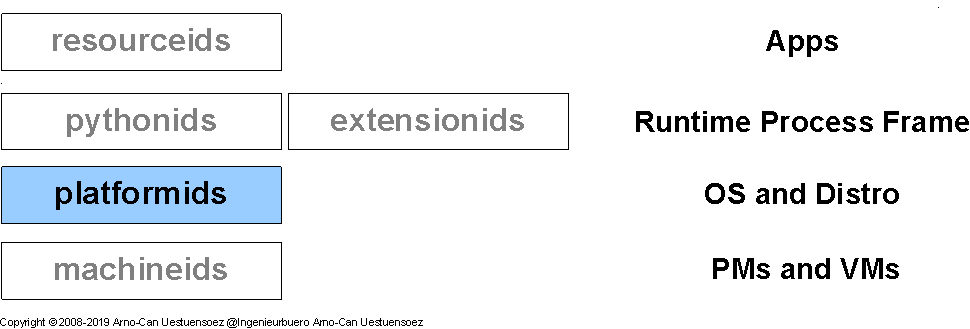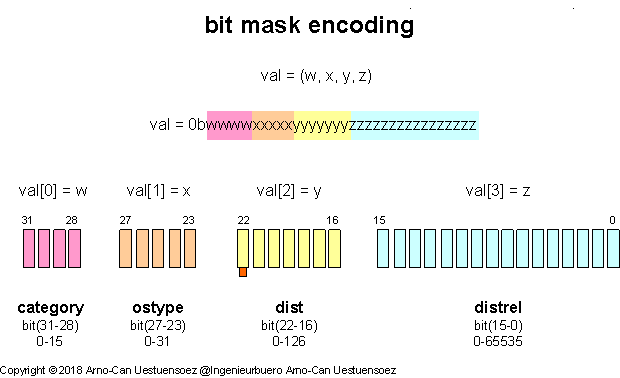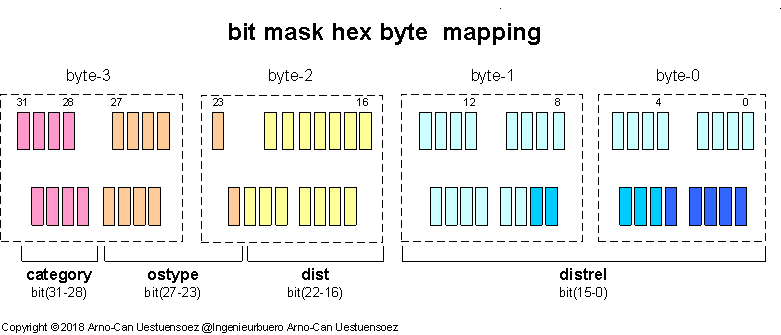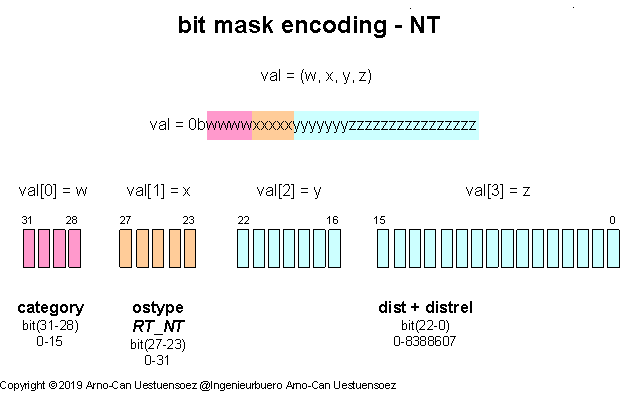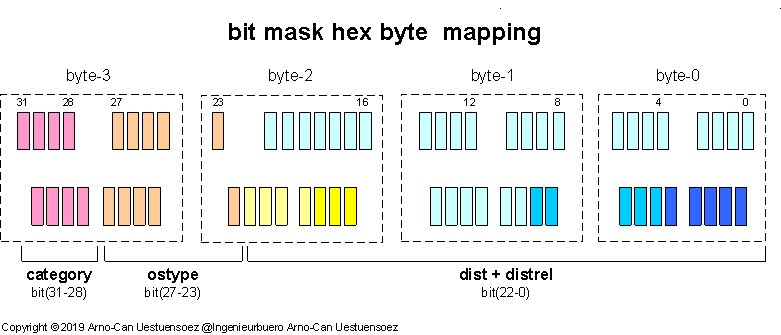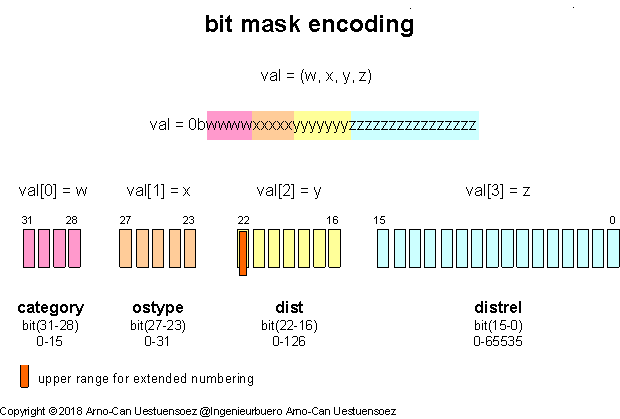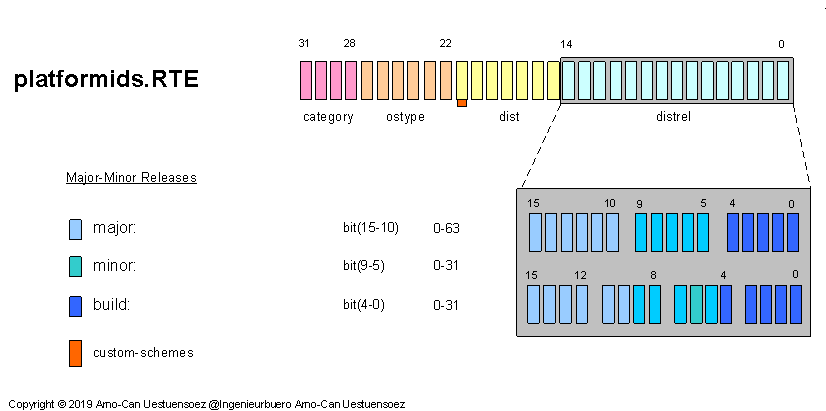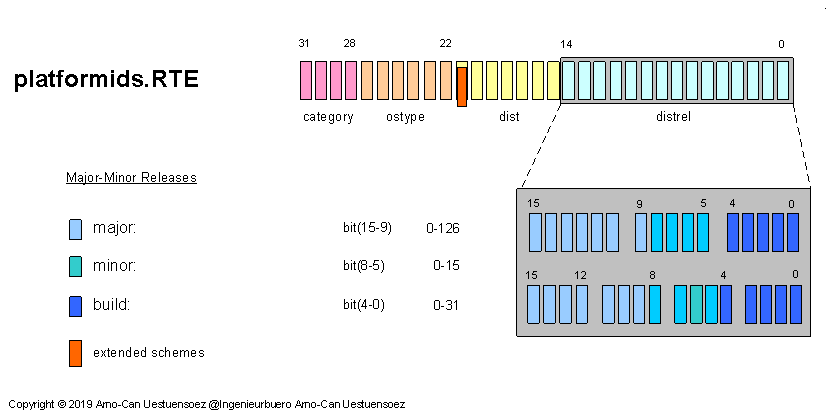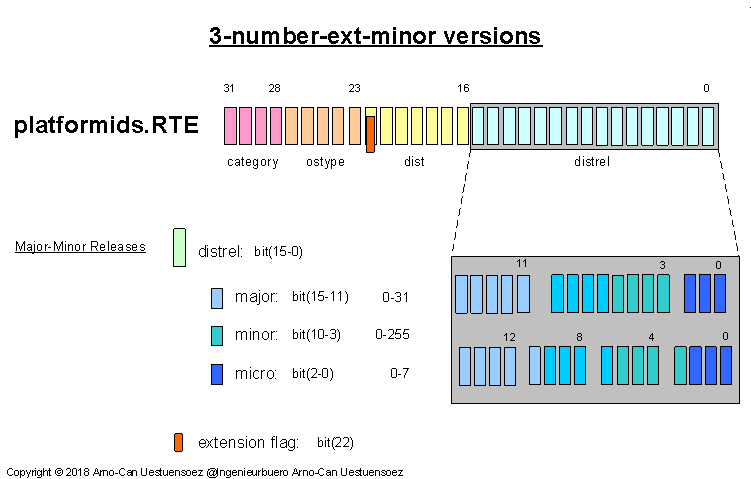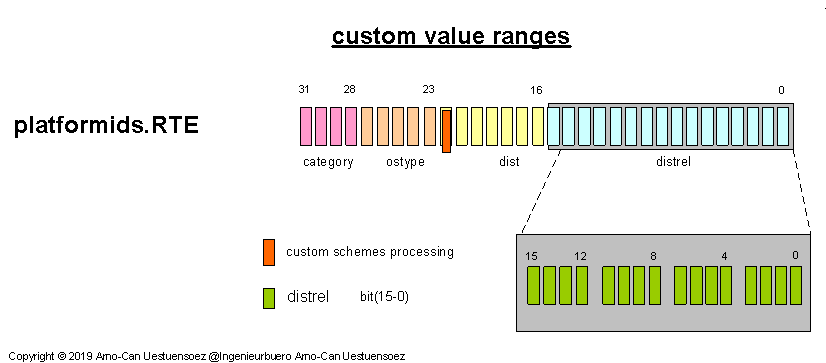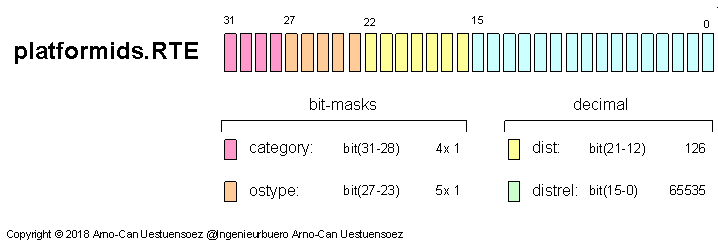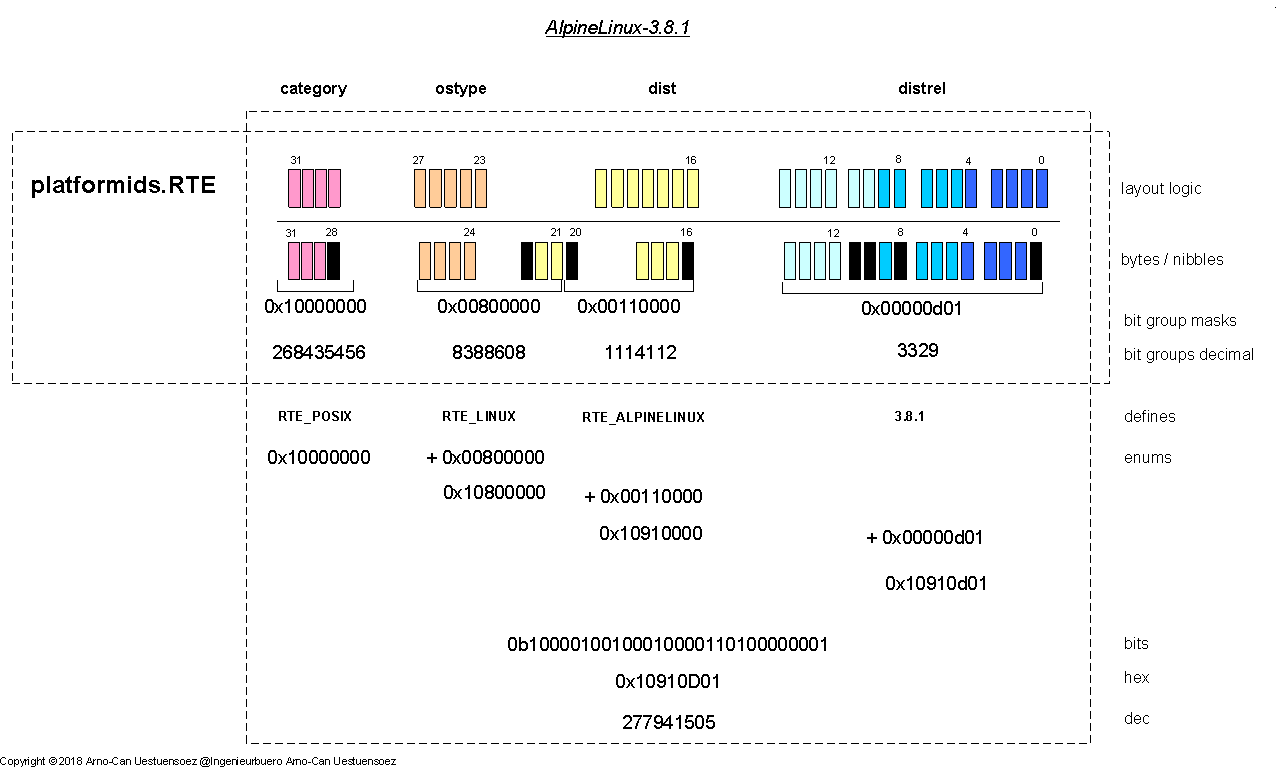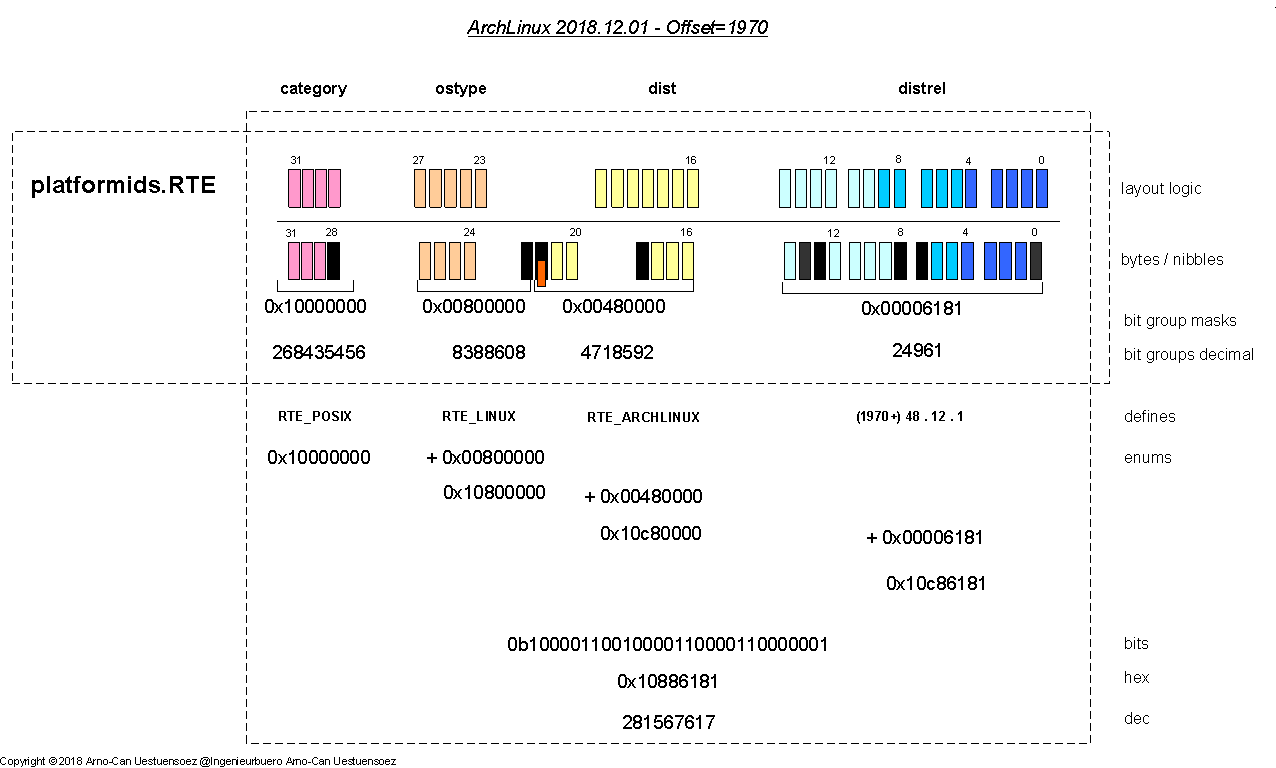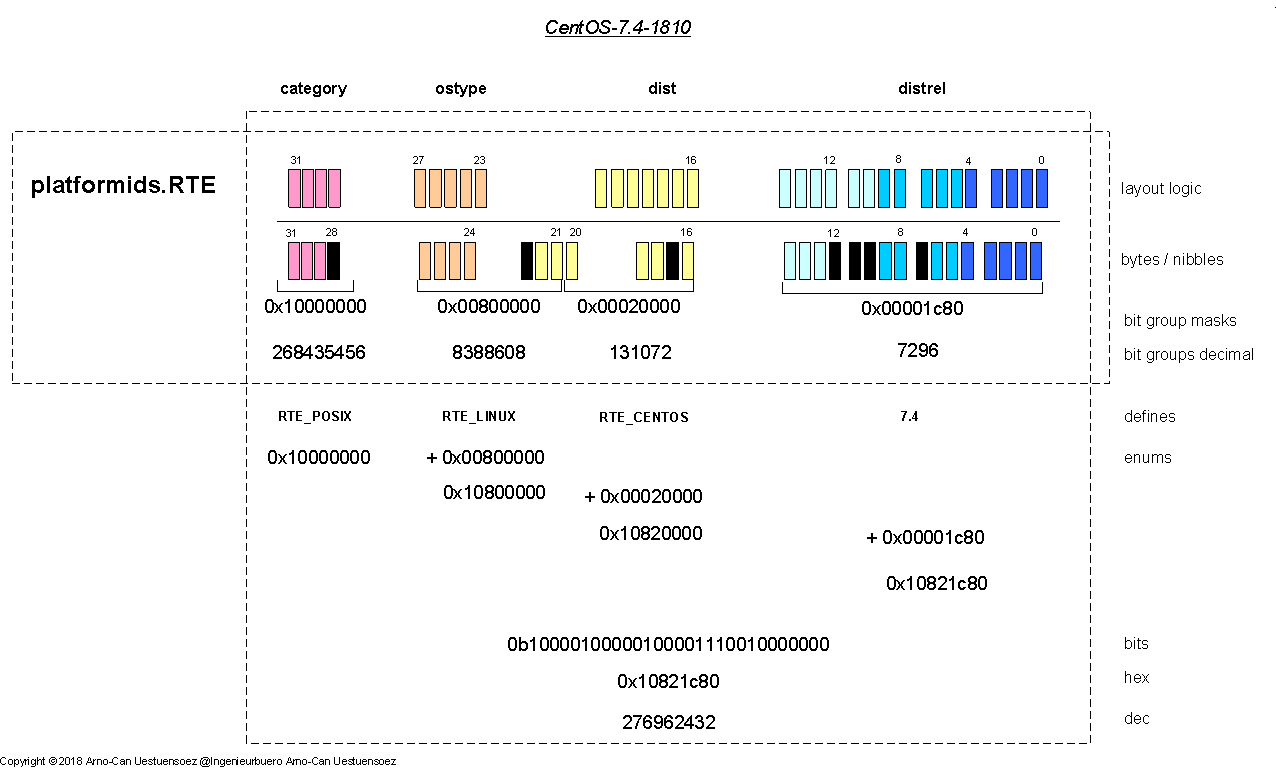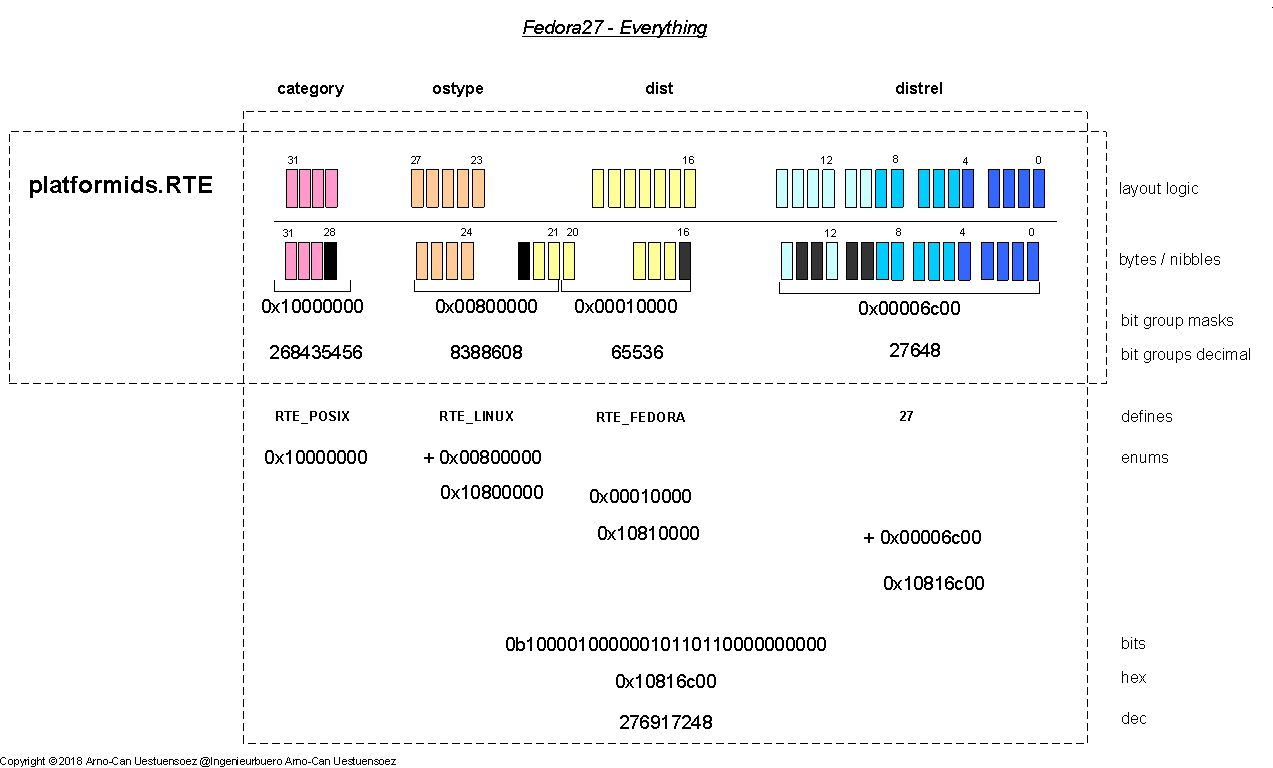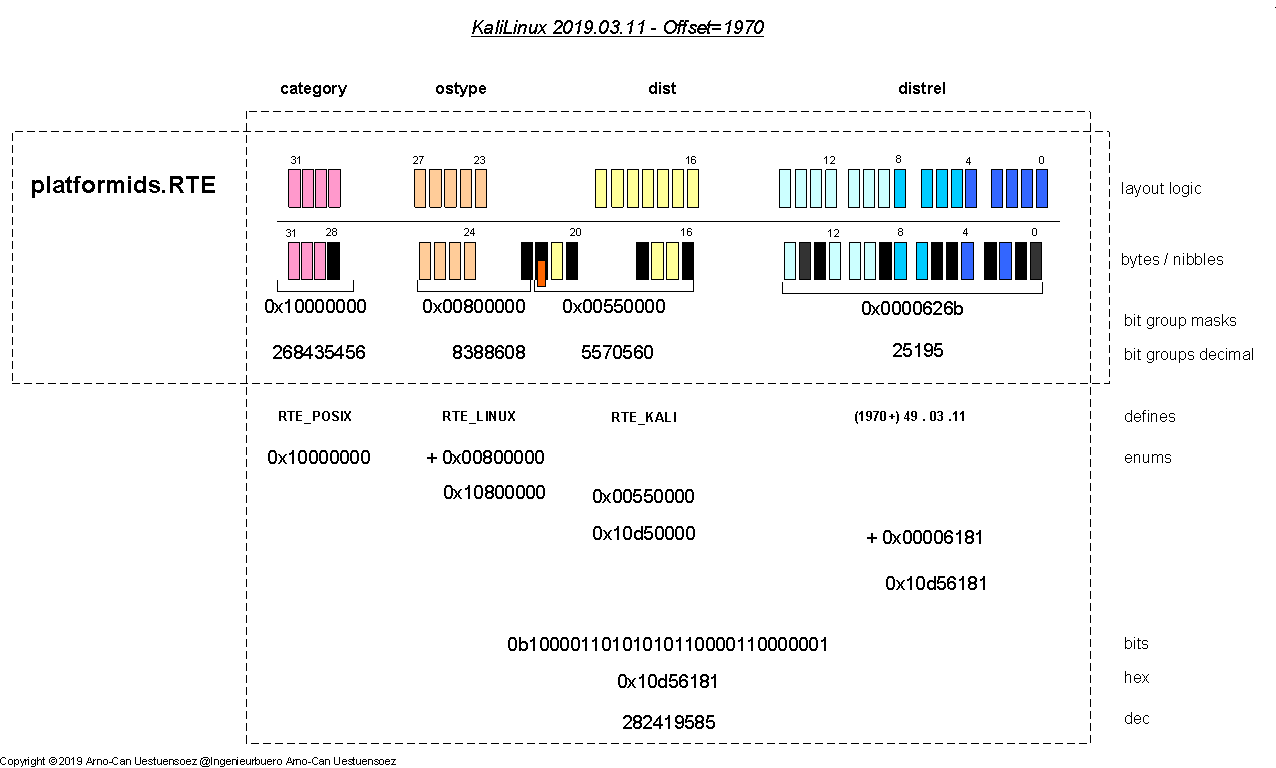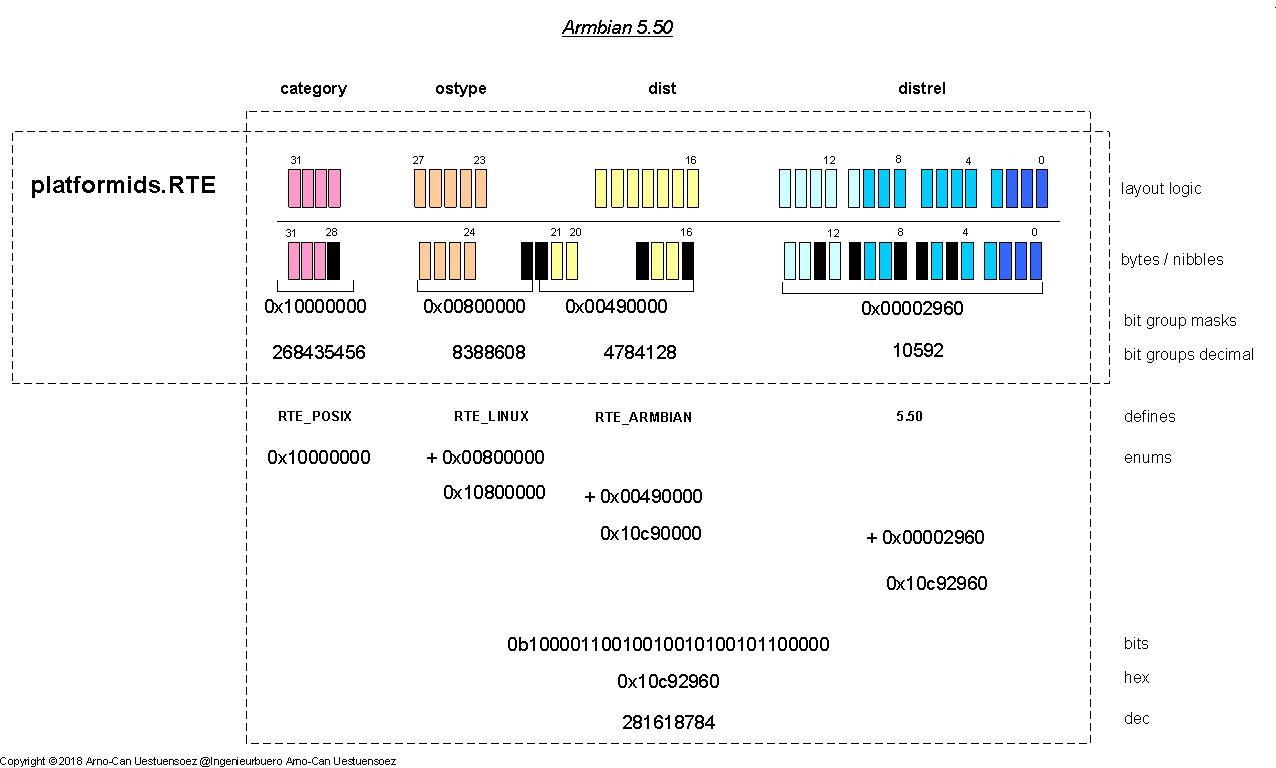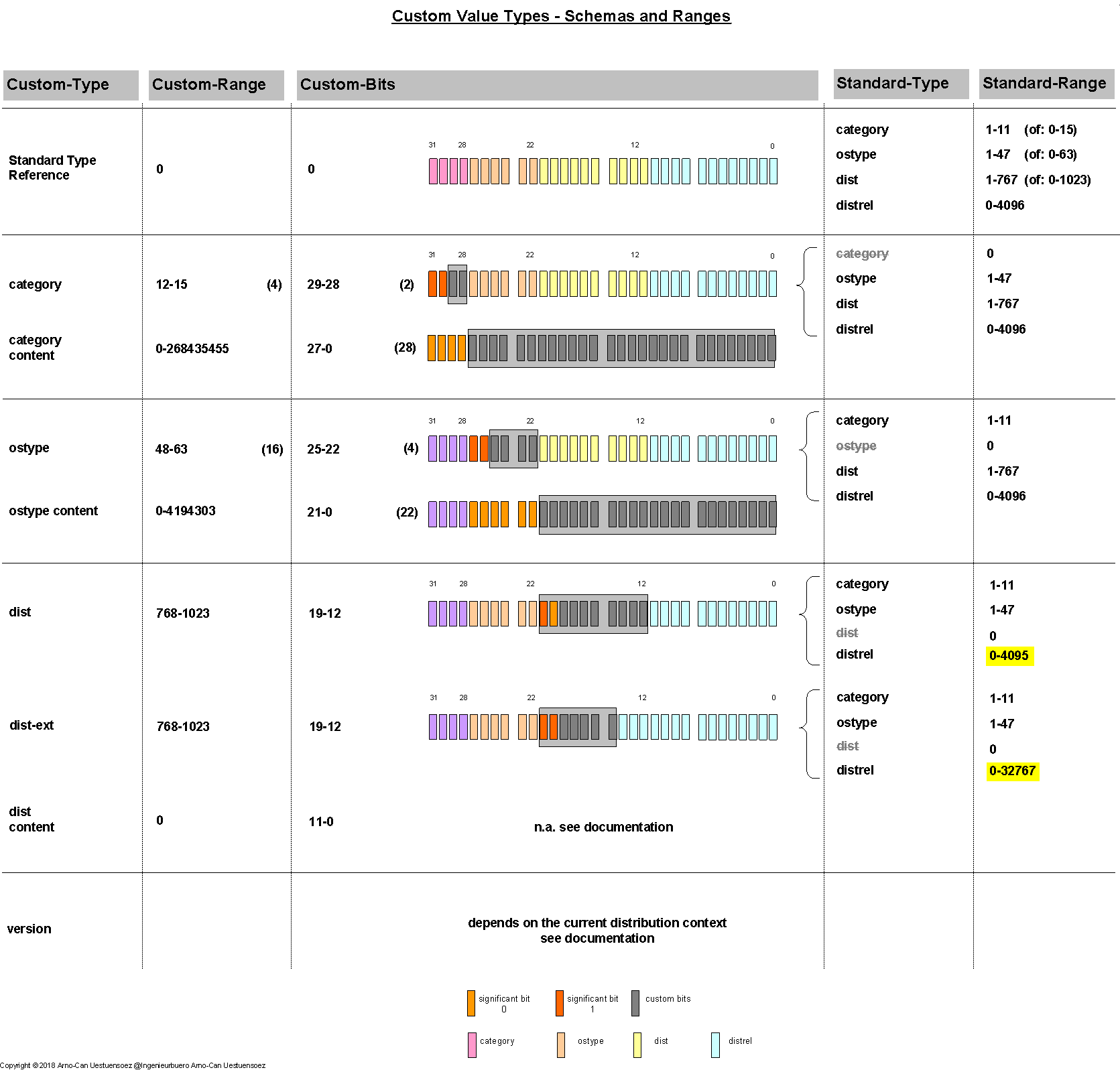5. OS Categorization¶
5.1. OS Type and Distribution Categorization¶
The type of the operating system and the packaged distribution comprise identifiers and information which are in a hierachical dependecy. It is essential to understand the logical hierarch of the naming and versioning schemes of OSs and it’s distributions in order to manage groupwise decisions like compatibility. The standard libraries of the various implementations provide here various inconsistent schemes, which lack a little of overall systematics. The introduced definition of category, ostype, distribution, and distribution-release constitute the basic relation and dependency of OS families, which are represented in the hierarchical numbering schemes by bitmasks.
<category-of-os>.<ostype>.<distribution>.<distribution-release>
For example the Linux OS, defined by the kernel release is the founding core of the distribution RHEL. The distribution follows it’s own identification scheme by releases and specific version numbers, while the base OS is released independent and included in multiple distributions. The distributions apply various different versioning schemes, which includes numeric schemes as well as string based naming of releases.
For example numeric release versioning:
Fedora27 := POSIX.LINUX.FEDORA."27" RHEL-7.5 := POSIX.LINUX.RHEL."7.5" CentOS-7.6-1804 := POSIX.LINUX.RHEL."7.6" # 1804 is additional code base info
or numeric release versioning with additional string names:
Debian-9.6 := POSIX.LINUX.DEBIAN."9.6" Debian-9.x := "Debian Stretch" OS-X-10.6.8 := "OS-X Snowleopard"
or string based distribution releases:
W10P := WINDOWS.NT.NT100."Windows10" W2019SE := WINDOWS.NT.NT100."Windows Server 2019 Essentials"
The representation of the OS and it’s packaging into distributions could be represented as a scalar value of encoded bitmasks similar to the Python version. The OS including the distribution is encoded here into a single 32bit value. The basic priciple of encoding multiple values into a hierarchical bitmask follows the same principles, see also Bit Masks for Numeric Vectors, and Python Categorization [pythonids].
5.1.1. Standards Compliance and Deviation¶
The identification of the platforms within the operating systems layer is commonly provided by the used OS. This implies the specific definition of value sets and value formats, even for releases of distributions. The diversity is resulting in a large variety of data representation. The first release of the concepts of multi-platform libraries for this project date back to the 90s for several UNIX distributions, and it’s wider OpenSource implementation with Linux, BSD, and Cygwin to 2008 by the project UnifiedSessionsManager [UnifiedSessionsManager], extended by Windows and OS-X 2011 by the version UnifiedSessionsManager-2.0.
The platformids provides a common standard set of values with unified representation including value formats. In addition numeric bit-masks within 32bit and 16bit ranges are defined for the efficient processing in dependent code sections.
Some major standards defined are Posix [POSIX], LSB [LSB], and Fredesktop [FREEDESKTOP]. This is accompanied by major defacto industry standards e.g. by the Microsoft Corp. [MICROSOFTINC] and Apple Inc. [APPLEINC].
The standard specifications are quite reluctant concerning the actual specific formats for each OS and derived distributions [OSList], [OSListLarge]. This is last but not least caused by the vast number of distributions resulting from the marketing startegies, but also the availability of the source code in the field of Linux ([LinuxDistComp], [LinuxPopular], …) and BSD([DRAGONFLY], [FREEBSD], [OPENBSD], …) OSs. In case of Linux almost 1000 distributions exist [DISTWATCH], which probably has to be provided in case of generic OpenSource([OSCompOpenSource]).
In case of e.g. of Windows OSs a large number of product versions are defined based on the internal OS specification. These product versions actually represent distributions with specific bundling of features including the priority of pricing([OSCompMSWin]). In addition the major difficulty resulting from the numbering scheme and value ranges applied by Microsoft products is the resulting value ranges, which is not optimized for the CPU register based processing. This would be desirable in particular for the loop processing in case of platform dependant libraries. One example for the sparse value utilization of wide types like 64bit is here OSVERSIONINFOEXA.wProductType, which actually utilizes 3-bits and mapped e.g. to ctypes.c_int8, but originally is defined by 64-bit. Another example is here OSVERSIONINFOEXA.wSuiteMask which provides a growing large number og enums for products originally defined by 64-bits, mapped to ctypes.c_int8. By the aspect of SW platform dependency processing these definitions are highly redundant, but may cost a lot of maintenance and performance overhead.
In case of OS-X or MacOS provided by Apple Inc. [APPLEINC] a systematic numbering scheme is established, but resulting in a sparse usage of the number spaces [OSXVERS].
All these special cases, exceptions, sparse value utilization of wide types like 64bit, and the arbitrary and over the time varying definition of identifiers and names including changes in numbering schemes are streamlined by the platformids into a platform independent common syntax of a continuous string and numeric value representation.
The main processing structures of the platformids are compressed into a 16bit and 32bit integer value as a bit-mask.
RTE(32-bit): Runtime Environment definition of the platform as a 32-bit value
PYVxyz(16-bit): The release of the current Python interpreter as a 16-bit value
The encoding into single scalar values of bitmasks reduces the processing overhead significantly, but further enhances the execution performance by restriction onto 32-bit values [PYINTPERF2VS3A], [PYINTPERF2VS3B].
The initial release focusses on standard sets, while the following support better for dynamic custom definitions and will further streamline the API.
The major interfaces are:
Representation of OS platforms:
Representation of Python releases:
The resulting gain is the reduction of the platform identification and/or verification onto a single integer operation for all supported platforms.
For the detailed concepts and design see the following sections.
5.1.2. Hierarchy of Platform and Infrastructure Stacks¶
The modern landscapes of information infrastructures are commonly designed and organized as stacks of runtime environments and provided as all-inclusive services for the excution of application processes based on common frameworks. This requires the design of the technical architecture of stacks consisting of the building blocks for the physical and virtual machines, operating systems, the execution frameworks for the runtime processes, and the application middleware including abstract system services.
5.1.3. Hierarchy of OS Distributions¶
The bit mask encoding for the operating system and the bundled distribution is slightly different than the encoding of the version. This is in particular due to the variations of the covered platforms and distributions, which are handeled differently for the categories. The main decision is here again to decide for an appropriate shared bit mask layout.
The design supports initially the subset of [OSList] as depicted in the following figure. The OS types BSD and UNIX behave here special in the sense that the common OS-Kernel is basically treated autonomous and continuously developed to a wider degree independently from the other family members. In contrast to this the Linux model provides a common OS-Kernel, which is extended by dynamic kernel modules and bundled into variants of packaging. This assures the common compatibility of the independently delivered OS-Kernel by the Linux-Foundation with the about 1000 [LinuxPopular] current existing distributions . The commercial OS types NT and Darwin of the by Microsoft Inc. and Apple Inc. provide a versioning model, where the Kernel is closed source and probably almost the invariant despite required maintenance and new APIs, while the system add-ons and applications evolve for each distribution release. The release pattern of some distribution varies further between classic version numbering [SWVERS], and continuous micro-deployment [RollingDist] while the version numbers remain.
The covered major categories by platformids are POSIX and MS-Windows systems including an emulation layer for mixed APIs like Cygwin and the subsystems of Windows, e.g. Windows.WSL.
5.1.3.1. POSIX¶
The POSIX based systems are commonly designed and distributed as Unix style systems, which regularly contain all services required for the application as a server and as a workstation. Thus any distribution could be configured easily as a server as well as a workstation, even as an embedded system.
An exception is here the commercial distribution of OS-X, which is bundled as a workstation or a server distribution.
The platformids models the logical hierarchy of POSIX [POSIX] based systems by sets as the mayor OS variation, and the subsets, which are the bundled distributions. Each distribution comprises a number of member releases. A specific distinction into server and workstation is not provided. Examples for the various numbering schemes are:
POSIX.BSD.DragonFlyBSD.DragonFlyBSD5 # is 5.0.0
POSIX.BSD.DragonFlyBSD.DragonFlyBSD54 # is 5.4.0
POSIX.BSD.FreeBSD.FreeBSD11 # is 11.0
POSIX.BSD.FreeBSD.FreeBSD112 # is 11.2
POSIX.BSD.OpenBSD.OpenBSD6 # is 6.0
POSIX.BSD.OpenBSD.OpenBSD63 # is 6.3
POSIX.Darwin.OSX.SnowLeopard # is 10.6.0
POSIX.LINUX.Archlinux.ArchLinux20181201 # Rolling distribution, but released by date based iso filenames
POSIX.LINUX.Armbian.Armbian550 # is debian-9.4 based, has own additional numbering scheme 5.50
POSIX.LINUX.CentOS.CentOS7 # is 7.0
POSIX.LINUX.CentOS.CentOS75 # is 7.5
POSIX.LINUX.CentOS.CentOS76 # new scheme 7.6-1810, is 7.6 with source from October 2018
POSIX.LINUX.Debian.Debian9 # is 9.0
POSIX.LINUX.Debian.Debian95 # is 9.5
POSIX.LINUX.Fedora.Fedora27 # single number-releases, is 27
POSIX.LINUX.RHEL.RHEL7 # is 7.0
POSIX.LINUX.RHEL.RHEL75 # is 7.5
POSIX.LINUX.Raspbian.Raspbian9 # is 9.0, same as base OS debian-9,0
POSIX.LINUX.Raspbian.Raspbian94 # is 9.4
POSIX.UNIX.Solaris.SOLARIS10 # is 10.0 - old numbering scheme, represents various patch levels
POSIX.UNIX.Solaris.SOLARIS11 # is 11.0
POSIX.UNIX.Solaris.SOLARIS113 # is 11.3
The mapped values are hereby basically independent from the version and build numbers as actually used by the OS.
For an overview refer to [UNIXHISTORY], for the underlying architecture see [machineids].
5.1.3.2. WIN¶
The Windows stack is designed slightly different than the POSIX stack. The never windows stack cosists mainly of distribution variants of the ostype NT. The dist value represents versions of NT, where a 2-number of version numbers is applied. The provided build id as the 3rd. version entry is - except one legacy release - redundant with the version. The focus of the platformids (see WindowsNT Versions) is here on product variants for a specific NT release, which is in particular covered by the marketing driven release names, see [OSVERSIONINFO] and.
This consequently requires an additional flag for the distinction of the server and workstation releases [OSVERSIONINFO].
The hierarchy defined by the platformids distinguishes therefore the NT releases and defined for each the actual product variations [WINVERSIONS].
Examples are:
Windows-7-6.1.7601-SP1 Windows-10-10.0.17134-SP0 Windows-XP-5.1.2600-SP3
WIN.NT.NT5_2.WIN2003STD
WIN.NT.NT6_0,WIN2008 # is OS type NT, distribution NT-6.0, build 6002, Windows Server 2008
WIN.NT.NT6_1.WIN2008R2 # is OS type NT, distribution NT-6.1, build 7601, Windows Server 2008 Release 2
WIN.NT.NT6_1.WIN7 # is OS type NT, distribution NT-6.1, build 7801, Windows 7
WIN.NT.NT6_1.WIN7H
WIN.NT.NT6_1.WIN7P
WIN.NT.NT6_1.WIN7U
WIN.NT.NT6_2.WIN2012STD
WIN.NT.NT6_2.WIN8P
WIN.NT.NT6_3.WIN2012R2STD
WIN.NT.NT6_3.WIN81P
WIN.NT.NT10_0.WIN10 # is OS type NT, distribution NT-10.0, build 1803, Windows 10
WIN.NT.NT10_0.WIN10 # is OS type NT, distribution NT-10.0, build 1809, Windows 10
WIN.NT.NT10_0.WIN10H
WIN.NT.NT10_0.WIN10P
WIN.NT.NT10_0.WIN2016STD
Some legacy examples for display only are former components of Windows-3.1 and Windows-95:
DOS.MSDOS.DOS.DOS622 # legacy example
WIN.WIN.WINDOWS.WIN31 # legacy example
WIN.WIN.WINDOWS.WIN311 # legacy example
WIN.WIN.WINDOWS.WIN95 # legacy example
For an overview refer to [OSWindows], for the underlying architecture see [machineids].
5.1.3.3. DOS¶
The former pure command line base system [DOS] also called as DOS has actually numerous variants [DOSLIST]. Represenation only of legacy examples are:
DOS.AMIGADOS.DOS.DOSxyz
DOS.APPLE.DOS.DOSxyz
DOS.DRDOS.DOS.DOSxyz
DOS.FREEDOS.DOS.DOS2016 [FREEDOS]
DOS.MSDOS.DOS.DOS622
DOS.PCDOS.DOS.PCDOSxyz
These may eventually be required for some industrial ‘appliances’ and legacy solutions. A typical former late-time application was to install BIOS updates. The recommended nowadays release for x86 based systems e.g. for BIOS updates is FreeDOS.
5.1.3.4. PWEMU¶
The combined Posix and Windows emulation layer. This is provided by various components within Windows-NT and the User-Lands of POSIX OSs. The difference to the following PEMU type is the seamless mixed emulation of PWEMU, while the the PEMU provides a distinguished and basically isolated pure POSIX emulation as an embedded emulated ‘alien’ environment for the cross-task.
The traditional PWEMU within the NT family is the OpenSOurce Cygwin whereas the provided POSIX environment by the company MKS Inc. was commercial. The attempt by Microsoft Inc. itself is provided by the POSIX-Subsytem, former as a part of the SDK.
Cygwin
Cygwin is a longterm NT extention layer which emulates a POSIX based environment, while the Windows based environment is still accessible [CYGWIN]. The POSIX emulation includes the programming API as well as the runtime environment by the command line interface of the POSIX based environment. various The provided parameters for Cygwin
category = posix dist = cygwin distrel = cygwin distrel_hexversion = 268435456 distrel_key = cygwin210 distrel_name = Cygwin-2.10.0 distrel_version = [2, 10, 0] ostype = cygwin ostype_version = [2, 10, 0]
5.1.3.5. PEMU¶
Windows.WSL
The combined Posix emulation layer as represented from NT10_0 on by the sub system linux Windows.WSL. The same architecture is basically founding the bash integration into NT-10.0.
Will be completed soon.
5.2. Bit Masks for Distribution Releases¶
The logical data hierarchy as depicted by the following figure is encoded into a bit mask scalar for single-operation or a few-operation steps of comparison operations. The encoding of the bitmask follows hereby various schemes, which depends on the concrete distribution. While the fields category and the ostype are defined generic, the distribution and in particular it’s version numbering scheme is defined by various paradigmas. The internal bitmask representaion therefore varies, while the API unifies these for high-level abstract processing.
The scalar representation of the OS and the distribution is given by the bit mask encoding comprising the OS type, the packaged distribution with the version. See the supported OS, and an overview of ‘existing’ operating systems [OSList].
5.2.1. Distribution Numbering Schemes¶
The OS distributions use a variety of release version numbering schemes.
5.2.1.1. Single Version Number¶
The case for a single version number represents the scheme for version numbering literally consisting of one integer value only. A prominent example is Fedora Linux.
The consequence here is the required wider range of possible values.
5.2.1.2. Major and Minor Version Number¶
The case of the Major-Minor version number represents the scheme for example for CentOS / RHEL, Debian, FreeBSD, OpenBSD, OpenSUSE, and Solaris starting with version 11.
The layout in this case is is driven by major releases with larger cycles and sub releases for fixes and minor to medium changes. Thus the range for the minor version number regularly requires larger values, while the major number is incremented commonly by larger release periods.
In some cases,e.g. for Armbian, the version is incremented mainly by usin the minor version number.
This requires some special extra handling due to the range.
5.2.1.3. Three-Value Version Number¶
The case for the three-value major release version numbering represents the scheme for example for OS-X [OSXVERS] and Windows.NT [WINVERSIONS]. The Linux variant OpenWRT is numbered by a 3-value scheme too. Another case is the 3-value enumeration based on dates and/or increments.
All of the following numbering schemes are basically sparely used, and exceed the provided standard bit-array sizes. These thus require either the extended mode, or a mapping of version labels onto incremental index values.
Some examples are:
OpenWRT [OPENWRT]:
A typical case for an equally used version number base on 3 values.
For details see OpenWRT.
macOS / OS-X [OSXVERS]:
The major version 10 is at least for a while constant, whereas the minor and micro version numbers are mainly used for version increments.
macOS / OS-X-10.6.0 - SnowLeopard macOS / OS-X-10.6.8 - SnowLeopard
For details see macOS / OS-X.
Windows-NT [WINVERSIONS]:
The OS WindowsNT or NT uses a version numbering scheme for the distributions, while the products as packaged distribution releases follown an independent business model with a separate naming space. The exception in the version numbering layout of Windows-NT occured with the release NT-10.0, when it announced a rolling release model
The old scheme just literally assembles the build number at the time of the release with the 2-number version of the planned distribution of NT.
NT-6.1.7601 - Windows-7 + Windows-2008 NT-6.3.9600 - Windows-8.1 + Windows-2012
The new scheme from NT-10.0 on distinguishes between version numbers and build numbers, where the version number labels a product release, while the build number keeps track of the rolling updates, which are much shorter in term than the produc release cycles.
Version numbers:
NT-10.0.1809 - Windows-10 + Windows-2016 + Windows-2019 - builds NT-10.0.17763.
Build numbers:
NT-10.0.17763 - Windows-10.0.1809 NT-10.0.17763.1 - Windows-10.0.1809 - Release Preview NT-10.0.17763.17 - Windows-10.0.1809 - with update KB4467228 - Slow ring and release preview: October 9, 2018
For details see Rolling Version, and Windows NT.
CentOS [CENTOS]
The distibution CentOS has recently changed to a scheme represented similarly starting with CentOS7 [CENTOSVERSIONS] / [CENTOSVERSIONSLATEST].
CentOS-7.0-1406 - CentOS-7.0 release date 2014.06 CentOS-7.1-1503 - CentOS-7.1 release date 2015.03 CentOS-7.5-1804 - CentOS-7.5 release date 2018.04 CentOS-7.6-1810 - CentOS-7.6 release date 2018.10
The major and minor version still keep to be significant, while the third number independently labels the date of the source-checkout, so is not a determining part of the version number.
For details see CentOS.
The third number has for the various distributions different semantics. In some cases the third number is part of the major number, while in others it represents an additional build index. In case of NT it even switched the semantics from incremental build numbering to a date based version number. Another variant is the independent hint to the release date of the code as a build base, so in case of CentOS.
5.2.1.4. Rolling Version¶
Rolling release versioning avoids fixed milestones of releases for packaged features, instaed tries to frequently deploy smaller updates, for further details see [RollingDist]. The application of rolling release workflow does not contradict the application of version schemes. The actual interpretation of this by some projects is not homogeneous. Some projects (seem?) not to provides a proper current release status detection, which is labeled by a release version. Thus the case for the rolling version has to be splitted. The main aspect to be handeled by platformids is the unified representation of all variants at the API.
It still remains - as for all other distribution at all - in the responsiblity of the admin, when manual non-standard updates are applied, which are not recognized by the distributions deployment mechanisms.
For the actual resulting implementation pattern see 3-number-date and Windows NT.
- Date based Three Number Version
The date based numbering scheme is in particular well suited for version-less schemes such as Rolling Distribution [RollingDist]. It is also the best native readable scheme for human interpretation. Sadly not all rolling distribution present a standard runtime API in order to use a date of the last refresh.
The only distribution - within the current supported set of rolling Linux distributions - which represents a release date API at all is KaliLinux. The release ID is stored within the ‘/etc/os-release’ file. Thus the release date evaluated from this file is used here as the current version.
For the current implementation of platformids refer to KaliLinux. For the new adapted-rolling numbering scheme of Windows-NT refer first to the following section.
- Windows-NT as OaaS
The new concept of Windows and WindowsNT in particular as an OS service - OaaS implies an updated sales and distribution concept. The new release paradigm of the WindowsNT or NT operating system distribution follows basically a combined release scheme paradigm. This fulfils for the technical update purposes the rolling paradigm with smaller short-term updates - almost consequnetly. While it satisfies the required business model by still defining packages of delivery for the sales of packaged products. Though it is basically a superposition of rolling and waterfall models.
The old scheme just literally assembles the build number at the time of the release with the 2-number version of the planned distribution of NT.
NT-6.1.7601 - Windows-7 + Windows-2008 NT-6.3.9600 - Windows-8.1 + Windows-2012
The new rolling scheme from NT-10.0 on distinguishes between version numbers and build numbers, where the version number labels a core OS product release, while the build number keeps track of the rolling updates, which are much shorter in term than the produc release cycles.
The version numbers are based on the release date of the core OS. These comprise the year offset from the year 2000, and the month of the release.
NT-10.0.1809 - Windows-10 + Windows-2016 + Windows-2019 - builds NT-10.0.17763. NT-10.0.1803 - Windows-10 + Windows-2016 + Windows-2019 - builds NT-10.0.17134.
The build numbers consis of two parts. The first part is the overall incremented build number of the first product release, while the second part is a relative incremented build counter for the released updates. This is linked to a release note supplied as a knowledge base issue, and an assigned version number.
NT-10.0.17763 - Windows-10.0.1809 NT-10.0.17763.1 - Windows-10.0.1809 - Release Preview NT-10.0.17763.17 - Windows-10.0.1809 - with update KB4467228 - Slow ring and release preview: October 9, 2018 NT-10.0.17134 - Windows-10.0.1803 NT-10.0.17134.619 - Windows-10.0.1803
To sumup the new versioning paradigm, it practices a kind of rolling release with little variation, while keeping the earned versioning scheme for their business modell alive. This in particular is quite helpful for the platformids when it comes to the ongoing update of the version numbering.
For details and curent implementation of platformids see Windows NT
- No Release Numbers
As already stated, some rolling distributions do not provide an easily applicable API or an API at all for the determination of the actual release state. To the understanding of the author it is not senseful to suppress the current state of the runtime platform installation at all. This is in particular annoying, when it comes to system related programming, which almost in any case requires some information of the underlying runtime platform infrastructure, in particular in heterogeneous cloud based environements. The rolling version paradigm does not prohibit the release numbering at all.
The supported distributions Arch Linux and Gentoo provide the release date as part of the name of their installation images, but seem not to offer any official runtime API in order to determine e.g. the update status of the distribution.
-
ArchLinux-2001.11.01 - archlinux-2018.11.01-x86_64.iso ArchLinux-2001.12.01 - archlinux-2018.12.01-x86_64.iso
See also [ARCHLIN], [ARCHLINVERSIONS], and [ARCHLINRELEASES].
-
Gentoo-2012.1 - livedvd-amd64-multilib-2012.1.iso Gentoo-2012.1 - livedvd-x86-amd64-32ul-2012.1.iso
For the current implementation of platformids refer to ArchLinux and Gentoo Linux.
-
5.2.1.5. State Driven Versions¶
The state driven versioning defines milestones when specific states of the software are reached.
This of course is the happiest type of version numbering  .
.
A typical example is here Slackware [SLACKWARE] with varying release dates. The numbering scheme is still basically incremental, while the associated release dates do follow a state of quality scheme rather than fixed scedule of predefined milestone dates.
-
Slackware-13.0 - 2009-08-26 Slackware-13.1 - 2010-05-24 Slackware-13.37 - 2011-04-27 (1) Slackware-14.0 - 2012-09-28 Slackware-14.1 - 2013-11-04 Slackware-14.2 - 2016-06-30
There is one exception (1) in the applied numbering scheme for the old version Slackware-13.37 / 2011-04-27 / EOL=2018-07-05. This will not fit into the default numbering scheme due the limited standard range of the minor version. But it is seen by the author as an singular exception of an EOL release for which no effort will be spent, and no runtime performance degredation will be accepted.
5.2.2. Bit Mask Layouts¶
The numeric representation is designed as a bitmask record containing logical sub-masks as fields, which model a hierarchical order. The supported distributions provide a variety of numbering schemes for the release versions which has to fit into the bitmask layout. The layout provides therefore a generic standard representation matching the majority of required numeric schemes, and the option to add prepared exceptions, or arbitrary custom schemes.
This section displays the logical record formats, while the detailed implementation patterns are depicted in the section ‘Bitmask Implementations’ and the actual specific implementation variants of each supported distribution ‘Supported Standard OS and Dists’ and ‘Embedded Systems and IoT’ .
5.2.2.1. Standard Numbering Scheme¶
The following bit-mask encoding layout represents the standard layout applicable to almost all supported distribution following a standard numbering scheme with version numbers up to 3 values. The sizes of the bit groups are designed to be sufficient for all most supported OS and distributions, which represent various versioning philosophies and different weights on resulting numbering schemes as well as various release incrementation periods. The range is foreseen to be sufficient for the applied numbering schemes at least for the coming 50 years.
The mapping scheme of the bit allocation within bytes is
The following table shows the available number ranges for the components of the bit array platformids.RTE.
bit-group
width
preferred operators
encoding
category
4bit
== & ^
|platformids
ostype
5bit
== & ^
|platformids os domains
dist
7bit
== & ^
|platformid dist domains
distrel
16bit
< > ==
domain specific version numbering
The distrel field is subdivided into the standard scheme 3-number-default, which covers almost all POSIX based distributions, e.g. CentOS, RHEL, Fedora, Debian, OpenBSD, macOS/OS-X, and Solaris11.
5.2.2.2. Windows NT Scheme¶
The Microsoft Windows versioning scheme follows a slightly different philosophy, where the ostype for Windows-NT defines also the distribution as an incremental ostype version. The naming scheme of the released ditributions is independet and follows a more marketing driven paradigm with various namings for the distribution variants and product classification [WINVERSIONS]. The versioning scheme behind the scenes is straight forward and incremental, this is still the case for the last change of the numbering paradigm. This scheme requires though a wider range of numbers for the distrel bit array.
Anyhow, in deviation to the other distributions the NT the release is effectivelly an OS release, while the packaging is defined by the product type and the product. This fits perfectly for the most common requirement of the enumeration of code segments for appropriate APIs. When additional information for product or producttype specific code segments is required, this has to be evaluated specifically.
The mapping scheme of the bit allocation within bytes is
The following table shows the available number ranges for the components of the bit array platformids.RTE.
bit-group
width
preferred operators
encoding
category
4bit
== & ^
|platformids
ostype
5bit
== & ^
|platformids os domains
dist
7bit
< > == & ^
|NT dist identification by major/minor numbering
distrel
16bit
< > == & ^
|NT dist versions by single int numbering (1)
(1): Old and new style of numbers:
Old style: build counter at release
New style(>=10.0): year-month at release
For the specific implementation see windows-nt.
5.2.2.3. Custom Numbering Scheme¶
coming soon
5.2.2.4. Rolling Version¶
Rolling release versioning avoids fixed milestones of releases for packaged features, instaed tries to frequently deploy smaller updates, for further details see [RollingDist]. The main aspect to be handeled by platformids is the unified representation of the data at the API.
- Date based Three Number Version
The date based numbering scheme is in particular well suited for versionless schemes such as Rolling Distribution [RollingDist]. It is also the best native readable scheme for human interpretation. The following scheme depicts the applied enumeration scheme. The required reorganization of the subranges of the version number requires specific treatment. Thus these are in general handeled for performance reasons by the upper numbering range.
The upper range in the context of the ostype Linux is activated when the bit 22 of the dist field is set. This enables the conditional processing of extended ranges by simple and fast detection of the range by bit operations, for the performance impact see ‘Logic Operations Performance’.
The mapping scheme of the bit allocation within bytes is
The fields for the month and date are kept here native with the appropriate number of bits. The field for the year is foreseen to contain 7-bits for an offset relative to a specific year, which provides a range of 0-126 years. The absolute year is calculated as the distance to a user defined offset. Thus this scheme provides a sufficient range while utilizing the numbers of required bits efficiently.
For an example refer to KaliLinux, which maintains the file ‘/etc/os-release’.
5.2.2.5. State Driven Versions¶
The state driven versioning defines milestones when specific states of the software are reached.
This of course is the happiest type of version numbering  .
.
A typical example is here Slackware [SLACKWARE] with varying release dates. The numbering scheme is still basically incremental, while the associated release dates do follow a state of quality scheme rather than fixed scedule of predefined milestone dates. The numbering scheme follows the default scheme Standard Numbering Scheme.
There is one exception in the applied numbering scheme for the old version Slackware-13.37 / 2011-04-27 / EOL=2018-07-05. This will not fit into the numbering scheme due the limited standard range of the minor version. But it is seen as an exception of an EOL release, for which no effort will be spent, and no runtime performance degredation will be accepted.
5.2.3. Performance of Comparison Operations¶
The provided standard information on OS and ditribution releases is fragmented across several interfaces. The data is presented by various parts with different data types. Some libraries provide a more condensed ste of data, but not comprising. The data is in general not primarily intended for frequent access by high performance routines.
The platformids provide therefore the information as numeric values only in order to enable fast comparison and range checks. The layout is still a compromise due to the huge amounts of distributions to be represented by a generic application. But resulting of the design the measured access on the various platforms offers speed improvements beginning by about 60% with frequently more than 300% compared to the usage of the standard data. The numeric representation in addition provides simpler code by avoiding the implementation of specific caching values.
The performance gain is e.g. in particular enhanced in comparison to interfaces like string.startswith(), which is directly applied to the standard string values. The gain is here more than 60% compared on all supported platforms.
5.2.3.1. Logic Operations Performance¶
The required treatment of multiple variants of bitmask layouts of version numbers requires some conditional code segments. In order to reduce the performance loss two choices these groups of cases are combined by specific value ranges. The programmatical decision could either be determined by the comparison operators of the numeric bistmasks or by simple bit operations in order to check the bit marking the beginning of the range.
This was measured by simple calls based on timeit, which undiscloses a performance impact of about 100%. The comparison operator requires e.g. 0.0261 usec
[acue@lap001 ~]$ python3 -m timeit -n 10000000 '12>8' 10000000 loops, best of 3: 0.0261 usec per loop
while the boolean bit operator requires e.g. 0.0116 usec
[acue@lap001 ~]$ python3 -m timeit -n 10000000 '12&8' 10000000 loops, best of 3: 0.0116 usec per loop
The relation is the same for various variants and repetitions, e.g.
[acue@lap001 ~]$ python2 -m timeit -n 1000000000 '12>8' 1000000000 loops, best of 3: 0.0222 usec per loop [acue@lap001 ~]$ python2 -m timeit -n 1000000000 '12&8' 1000000000 loops, best of 3: 0.0134 usec per loop
including other CPython releases.
acue@lap001 ~]$ python3 -m timeit -n 100000000 '12>8' 100000000 loops, best of 3: 0.0267 usec per loop [acue@lap001 ~]$ python3 -m timeit -n 100000000 '12&8' 100000000 loops, best of 3: 0.0118 usec per loop
5.2.4. Bitmask Implementations¶
The standard schemes and layouts are implemented and tested for all supported platforms, and should work on all standards based. The aquisition of the OS and distribution data may in some cases rely on non-standard sources or number ranges, thus in these cases the application has to implement an adapted custom scheme. An example is here Armbian, which dominantly increments version numbers by the minor version number.
5.2.4.1. 3-number-default¶
The 3-number default scheme provides the common default release numbering scheme for the vast majority of the distributions for all OS types. For distributions where the ranges fit, but which use less numbers, the remaining are filled with zero. E.g. for ‘Fedora27’ the resulting version numbering is ‘27.0.0’. The following figure depicts the logical standard subfield allocation within the distrel field.
With the detailed byte mapping
5.2.4.2. 3-number-date¶
The 3-number date scheme provides the version numbering based on date entries. This is in particular the case for rolling releases. The bit layout is based on the epoch time or also known as unixtime [UNIXTIME]. The field distrel contains the subfields year, month, and day. The following figure depicts the logical standard subfield allocation within the distrel field. The adapted encoding relies on the value ranges with the set bit 22 for specific numbering.
With the detailed byte mapping
The number of available bits is 16, thus the value is encoded as a compressed value incremented relative to an anchor. The number of years is counted relative to the unixtime or epoch time, which is the 1.1.1970 00:00:00, while the month and day values are locally relative. This enables in particular a tight integration into the commonly available library functions for time and date processing. The value range for the number of years is 7bit wide, thus provides a range of 0-125. Therefore the possible range of representation is
1.1.1970 - 31.12.2095
Even though limited, the range as an incremental numbering scheme is spoken in computing ages ‘almost endless’ and in line with the design goal of applicability at least for the next 50 years. Thus within the decision base of the 32bit bitmask-vector.
The unixtime is known to going to have the Year-2038 problem [YEAR2038] due to it’s common limitation
to an 32bit unsigned integer value.
The standard calculations with the 3-num-date format are not affected by this limitation.
But when system libraries are used it may.
But anyhow, this issue is so important, thus will be solved until 2038 appropriately - for sure  .
.
Typical applications are here for the Linux based OS Archlinux, Gentoo, and KaliLinux.
5.2.4.3. 3-number-minor-ext¶
The 3-number-minor-ext scheme provides the release numbering scheme where the increment priority is laid on the minor version number. This is e.g. the case for Armbian with the current version ‘Armbian-5.50’. The following figure depicts the logical standard subfield allocation within the distrel field.
With the detailed byte mapping
5.2.4.4. custom-distrel¶
The dist field of the ostype context RTE_LINUX is subdvided by the significance of bit 22 into two equal ranges of 63 distributions. The platformids reserves some values for the standard distributions in both ranges, for the supported and tested standard distributions with standard numbring schemes and the special schemes like rolling release distributions. The upper range of 63 distributions is reserved for optional special numbering schemes, while the default scheme is still the the common 3 number scheme. The limitation just touches the number of distributions to be handeled at once. While the assignment is dynamic, though basically not limited for almost all use-cases of practical relevance.
- Concept
The custom scheme is activated when the extension flag is set. This includes the standard special cases of non-default schemes as well as schemes dynamically registered by the applications.
In this case the provided interface of the corresponding module is called, which may define it’s own free layout of the distrel field and implement customized processing.
This includes the custom byte mapping of the distrel.
Even though hard-coded for performance reasons, the supported Posix based standard distributions with non-default version layouts utilize exactly this case. So KaliLinux, ArchLinux, Gentoo, and Armbian.
- Examples
ffs.
Parrot Linux
5.2.5. OS Numbering Schemes¶
Will be available soon.
5.3. Global Variables¶
The provided global variable platformids.RTE is initialized during the load of platformids by the automated scan of the current platform platformids.platforms.PlatformParameters.scan() .
The bit masks could be applied in each sub hierarchy by a domain specific encoding. This frequently comprises numbering schemes for specific Linux distributions, but could comprise for example the dist and distrel fields as for example for the categories of posix.darwin.osx, where OSX uses a 3-number version scheme.
5.4. Special Dependencies of Python¶
The standard distribution and the closely designed Python implementations share more or less a common view and semantics within their interfaces including the provided standard libraries. This is different to some degree when it comes to cross-platform Python implementations such as Jython. One example is here the different paradigma of the degree of the encapsulation of the underlying system resources. While the C/C++ based standard distribution and it’s close allys refer to the platform as the underlying OS and distribution resources, the Jython implementation sets here an abstract view of the JVM as it’s platform. Referring to the native platform as the underlying OS and distribution information.
The system programming in particular of infrastructure applications therefore require here to go some extra miles in order to identify the actually required common information about the native platform. See also [pythonids].
5.5. Supported Standard OS and Dists¶
The current actively supported and tested OS and distributions are listed in the following table.
More distributions are supported generically, but not explicitly tested by the author.
For an graphical overview of in general supported platforms refer to
‘Unix History - Simplified Overview’[UNIXHISTORY]  ,
and
‘Microsoft timeline of operating systems’ [MSOSHISTORY]
,
and
‘Microsoft timeline of operating systems’ [MSOSHISTORY]  .
The current supported set of OS by ‘PlatformIDs’
.
The current supported set of OS by ‘PlatformIDs’  as listed in the following table,
where the tests include the complete set of supported Python implementations as defined by pythonids [pythonids]
as available.
as listed in the following table,
where the tests include the complete set of supported Python implementations as defined by pythonids [pythonids]
as available.
category
ostype
dist
tested distrel
bit-mask
doc
ref
py
test status
scheme
(8)
RTE_POSIX
RTE_BSD
RTE_FREEBSD
11.2
cij
OK
RTE_NETBSD
cij
RTE_OPENBSD
6.4
cijp
OK
RTE_DARWIN
RTE_OSX
10.6.8
cij
OK
RTE_LINUX
RTE_ALPINELINUX
3.8.1
cij
OK
RTE_ARCHLINUX
20181101 + updates
cij
OK
RTE_CENTOS
6.*
cij
OK
7.*
cij
OK
RTE_DEBIAN
9.*
cij
OK
RTE_FEDORA
27
cijp
OK
28
cijp
OK
29
cijp
OK
RTE_GENTOO
cij
RTE_OEL
7.*
cij
OK
RTE_OPENSUSE
15.*
cij
OK
RTE_RHEL
7.*
rhel <DIST_MODULE_RHEL>
cij
OK
8-preview
rhel <DIST_MODULE_RHEL>
cij
OK
RTE_SLES
15.*
c
OK
RTE_UBUNTU
16.04.*
cij
OK
18.04.*
cij
OK
18.10.*
cij
OK
RTE_UNIX
RTE_SOLARIS
10
default (7)
cij
OK
11.2
cij
OK
RTE_WINDOWS
RTE_NT
RTE_NT5_0
5.0.2195 (5)
c
(OK) (11)
RTE_NT5_1
5.1.2600 P (5)
cijr (10)
OK (10)
RTE_NT5_2
5.2. (9)
RTE_NT6_0
6.0
RTE_NT6_1
6.1.7601 U (5)
cijpr
OK
RTE_NT6_1
6.1.7601 S (5)
cijpr
OK
RTE_NT6_2
–
RTE_NT6_3
6.3.9600 P (5)
cijpr
OK
RTE_NT6_3
6.3.9600 S (5)
cijpr
OK
RTE_NT10_0
1809 P+H (5)
cijpr
OK
RTE_NT10_0
1809 S (5)
cijpr
OK
RTE_NT10_0
1809 SE (5)
cijpr
OK
RTE_NT10_0
1809 S (5)
RTE_NT10_0
1511 (5)
RTE_PWEMU (1)
RTE_CYGWINNT
RTE_CYGWIN
2.6
cijpr
OK
- (1): RTE_PWEMU
The RTE_PWEMU represents the seamless combined native inbound POSIX emulation and API translators on WINDOWS, currently Cygwin only. A similar emulator/translator was/is provided by Mortice Kern Systems Inc. [MKS] now PTC.
- (2): RTE_WPEMU
The RTE_WPEMU represents the virtual emulation of Windows on POSIX, and API translators, e.g. to the opposite direction as represented by Wine [WINE].
- (3): RTE_REACTOS
The RTE_REACTOS represents the Windows-NT clone based on WIN2003 / NT5_2. It aims to be binary compatible with full degree drop-in replacement down to driver level [REACTOS].
- (4): RTE_AIX13
The RTE_AIX13 represents “AIX 1.3 for PS/2” executed within VirtualBox. The release is outdated and far behind it’s EOL, thus meant for test and demo purposes only.
- (5): Microsoft Product Variants
The charactes signify the following product variants:
H: Home Edition
U: Ultimate Edition
P: Professional Edition
S: Server
SE: Server Essentials
(7): Solaris10
- (8): Python Implementation
c: CPython, by default cpython-2.7.x, cpython-3.5.x, cpython-3.6.x, cpython-3.7.x, and , cpython-3.8.x-pre-release
i: IPython, by default combined with CPython
j: Jython, by default Jython-2.7.0 with jdk1.8.0_131, jdk1.8.0_181, jdk1.8.0_202, openjdk-11.0.2, and/or openjdk-12.0.0
p: PyPy, by default pypy2-6.0.0, and pypy3-6.0.0
r: IronPython, by default IronPython-2.7.7, and/or IronPython-2.7.9
The tested versions on old systems are the newest possible. This is limited e.g. on WindowsNT platforms by the supported installer and the compiler in case of an intended alternate compilation.
- (9): Windows-2003 + Windows-2003R2
The Windows-2003R2 release is the only and one execption from the numbering scheme of the R2 releases, which normally were assigned the incremented NT release of the following version. In case of Windows-2003R2 the dist number was kept.
- (10): cijpr
All are supported as version 2 only.
- (11): (OK)
Limited features due to platform libraries.
Custom Examples:
category
ostype
dist
tested distrel
bit-mask
doc
ref
py
test status
scheme
(8)
RTE_POSIX
RTE_BSD
RTE_DRAGONBSD
c
OK
RTE_GHOSTBSD
RTE_NOMADBSD
c
RTE_TRUEOS
c
RTE_LINUX
RTE_LINUXMINT
c
OK
RTE_SLACK
c
OK
RTE_MINIX
RTE_MINIX2
c
OK
RTE_MINIX3
c
OK
RTE_UNIX
RTE_AIX
1.3
c
RTE_WINDOWS
RTE_REACTOS
RTE_REACTOS5_2
0.4.9
c
5.6. Linux¶
5.6.1. Alpine Linux¶
For the module description refer to platformids.dist.alpinelinux.
type
enum
string
remarks
category
RTE_POSIX
posix
ostype
RTE_LINUX
linux
dist
RTE_ALPINE
alpinelinux
distrel
see alipine.py
see [ALPINEVERSIONS], scheme default
pretty
AlpineLinux
The value ranges and incremental behaviour fit into the standard scheme. The AlpineLinux distribution uses the default versioning scheme.
The current version at the time of writing is:
AlpineLinux-3.8.1
The following example shows the encoding for the runtime environment of AlpineLinux
Resulting in the bitmask:
or the final encoding:
See also alpinelinux.py
5.6.2. Arch Linux¶
For the module description refer to platformids.dist.archlinux.
type
enum
string
remarks
category
RTE_POSIX
posix
ostype
RTE_LINUX
linux
dist
RTE_ARCHLINUX
archlinux
distrel
see archlinux.py
pretty
Arch Linux
The Arch Linux distribution [ARCHLIN] is based on the Rolling Release philosophy [RollingDist]. Therefore it virtually supports one release over it’s life cycle with frequent small fixes and updates. The production dates are provided for files - e.g. ISO images - in order to avoid collisions of file system names, while the runtime system itself does not provide any release numbering.
Note
The legacy file /etc/arch-release is empty, though itself a label for Arch Linux itself. The names of the provided ISO images are currently not available for the runtime system. The /proc directory does not provide sufficient information either.
Thus the platformids provide as the basic information of the installation state for now the last modification time of the package cache directory of pacman. For details and remarks on actual reliability refer to Rolling Version Identifier.
Examples for the Arch Linux ISO file production naming are:
archlinux => 0x1050f000 archlinux-2018.06.01 => 0x1050f0c1 archlinux-2018.10.01 => 0x1050f111 archlinux-2018.11.01 => 0x1050f121 archlinux-2018.12.01 => 0x1050f131
The offset for ArchLinux is the standard offset unixtime 1970.1.1:
archlinux => 0x1050f000 archlinux-2018.12.01 => 0x1050a581
Resulting in the bitmask: The following example shows the encoding for the runtime environment of ArchLinux
Resulting in the bitmask:
or the final encoding for the default offset of the year 1970.1.1:
The field VERSION in the file /etc/os-release [OSRELEASE] is supported as an optional custom value which is scanned into the internal version numbering scheme. This provides for the modelling of more granular version dependencies, but requires the maintenance of the file. Optionally any file system path could be provided to a local custom file with the same format as os-release.
See Arch Linux.py
5.6.3. CentOS¶
For the module description refer to platformids.dist.centos.
type
enum
string
remarks
category
RTE_POSIX
posix
ostype
RTE_LINUX
linux
dist
RTE_CENTOS
centos
distrel
see centos.py
see [CENTOSVERSIONS], scheme default
pretty
CentOS
The distribution CentOS has changed it’s numbering scheme slightly beginning with the release CentOS7 [CENTOS]. The actual numbering remains the same as for the previous releases, while the date of the code base is added by a preceding hyphen as a hint for further builds. The old numbering scheme
CentOS-6.9 CentOS-6.10
the new scheme from CentOS7 on is
CentOS-7.0-1406 CentOS-7.1-1503 CentOS-7.2-1511 CentOS-7.3-1611 CentOS-7.4-1708 CentOS-7.5-1804 CentOS-7.6-1810
Thus the actual numbering scheme of relevance for the platform dependency ramains as before. The platformids therefore just ignores the code base suffix.
CentOS-7.0-1406 -> 7.0 CentOS-7.1-1503 -> 7.1 CentOS-7.2-1511 -> 7.2 CentOS-7.3-1611 -> 7.3 CentOS-7.4-1708 -> 7.4 CentOS-7.5-1804 -> 7.5 CentOS-7.6-1810 -> 7.6
The applied encoding is here the default pattern.
The scheme domain for the numbering of CentOS [CENTOS] releases is based on classical 2-number version identifiers. The third entry since the introduction in 7.4 - e.g. 7.6-1810 - represents the additional information of the used source code snapshot, thus is for the version numbering scheme not relevant.
The following example shows the encoding for the runtime environment of CentOS-7.6.1810
Resulting in the bitmask:
or the final encoding
This layout focusses on the supported distributions and enables for those direct comparisons and membership checks by single logical operations. While the versions and releases are still ordered for threshold and range operations.
See centos.py
5.6.4. Cygwin¶
For the module description refer to platformids.dist.cygwin.
type
enum
string
remarks
category
RTE_PWEMU
pwemu
ostype
RTE_CYGWINNT
cygwinnt
dist
RTE_CYGWIN
cygwin
distrel
see cygwin.py
see [CYGWINVERSIONS], scheme default
pretty
Cygwin
Cygwin emulates a POSIX environment on Windows [CYGWIN]. The version numbering for Cygwin is based on a 3-number version format, where the numbers change moderately, the current used version is 2.9.0.
The applied encoding is here the default pattern.
Some examples are:
cygwin-2.9.0
See cygwin.py
5.6.5. Debian¶
For the module description refer to platformids.dist.debian.
type
enum
string
remarks
category
RTE_POSIX
posix
ostype
RTE_LINUX
linux
dist
RTE_DEBIAN
debian
distrel
see debian.py
see [DEBIANVERSIONS], scheme default
pretty
Debian
The distribution Debian [DEBIAN] applies the standard pattern for a 2-number version. Examples are:
debian-8.2 debian-9.3 debian-9.4 debian-9.5 debian-9.6
The applied encoding is here the default pattern.
See debian.py
5.6.6. Fedora¶
For the module description refer to platformids.dist.fedora.
type
enum
string
remarks
category
RTE_POSIX
posix
ostype
RTE_LINUX
linux
dist
RTE_FEDORA
fedora
distrel
see fedora.py
see [FEDORAVERSIONS], schema default
pretty
Fedora
The scheme domain for the numbering of Fedora [FEDORA] releases is based on frequent short-term scheduled release cycles with a single major version number only. For example Fedora27, Fedora28, and Fedora29 as the versions active at the time of the writing this section. For the naming scheme of former releases see [FEDORARELNAMES].
fedora-27 fedora-28 fedora-29
The applied encoding is here the default pattern.
The following example shows the encoding for the runtime environment of Fedora27
Resulting in the bitmask:
or the final encoding
See fedora.py.
5.6.7. Gentoo¶
See gentoo.py, [GENTOOVERSIONS].
5.6.8. OpenSUSE¶
For the module description refer to platformids.dist.opensuse.
type
enum
string
remarks
category
RTE_POSIX
posix
ostype
RTE_LINUX
linux
dist
RTE_OPENSUSE
opensuse
distrel
see opensuse.py
see [OPENSUSEVERSIONS], schema default
pretty
OpenSUSE
The applied encoding is here the default pattern.
Examples are:
opensuse-15.1 - leap opensuse-42.3 - leap
See opensuse.py, [OPENSUSE], and for legacy [SUSE].
5.6.9. Oracle Enterprise Linux¶
For the module description refer to platformids.dist.oraclelinux.
type
enum
string
remarks
category
RTE_POSIX
posix
ostype
RTE_LINUX
linux
dist
RTE_OEL
oraclelinux
distrel
see oraclelinux.py
see [ORACLELINVERSIONS], schema default
pretty
Oracle Enterprise Linux (*)
- (*): The variant of Oracle derived from RHEL
The name has changed multiple times, e.g. Unbreakable Linux, Oracle Linux, …
The distribution Oracle Enterprise Linux or OEL applies the same classic 2-number version scheme as CentOS. The syntax is slightly modified and represents the version similar to the Java releases by using the update marker by a u instead of a dot.
OEL-6u9
OEL-7U6
The applied encoding is here the default pattern.
See oraclelinux.py
5.6.10. RHEL¶
For the module description refer to platformids.dist.rhel.
type
enum
string
remarks
category
RTE_POSIX
posix
ostype
RTE_LINUX
linux
dist
RTE_RHEL
rhel
distrel
see rhel.py
see [RHELVERSIONS], schema default
pretty
RHEL
The distribution RHEL applies the standard pattern for a 2-number version. Examples are:
rhel-6.2 rhel-6.4 rhel-7.2 rhel-7.3
The applied encoding is here the default pattern.
See rhel.py
5.6.11. SLES¶
For the module description refer to platformids.dist.sles.
type
enum
string
remarks
category
RTE_POSIX
posix
ostype
RTE_LINUX
linux
dist
RTE_SLES
sles
distrel
see sles.py
see [SLESVERSIONS], schema default
pretty
SLES
The distribution SLES applies the standard pattern for a 2-number version. Examples are:
sles-15.1
The applied encoding is here the default pattern.
See sles.py
5.6.12. Ubuntu¶
For the module description refer to platformids.dist.ubuntu.
type
enum
string
remarks
category
RTE_POSIX
posix
ostype
RTE_LINUX
linux
dist
RTE_UBUNTU
ubuntu
distrel
see ubuntu.py
see [UBUNTUVERSIONS], schema default
pretty
Ubuntu
The distribution Ubuntu versions are based on standard 2-number scheme.
Ubuntu-16.04 Ubuntu-18.04 Ubuntu-18.10
The applied encoding is here the default pattern.
See ubuntu.py
5.7. BSD¶
5.7.1. FreeBSD¶
For the module description refer to platformids.dist.freebsd.
type
enum
string
remarks
category
RTE_POSIX
posix
ostype
RTE_BSD
bsd
dist
RTE_FREEBSD
freebsd
distrel
see freebsd.py
see [FREEBSDVERSIONS], schema default
pretty
FreeBSD
The distribution FreenBSD [FREEBSD] applies the standard pattern for a 2-number version. Examples are:
freenbsd-11.1 freenbsd-11.2 freenbsd-12.0
The applied encoding is here the default pattern.
The newer release versions follow a 2-number scheme, but provided in the past a 3-number scheme, e.g. the releases 3.5.1 and 4.1.1. Examples for the provided value ranges are <major><minor><build> :
Current 12.0.0 - 2019:
major : 6-bits -> 0..61 - current: 12
minor : 4-bits -> 0..15 - current: 0
index : 2-bits -> 0..3 - current: 0
Last 11.2.0 - 2018:
major : 6-bits -> 0..61 - last: 11
minor : 4-bits -> 0..15 - last: 2
index : 2-bits -> 0..3 - last: 0
Historic 4.1.1 - 2000:
major : 6-bits -> 0..61 - historic: 4
minor : 4-bits -> 0..15 - historic: 1
index : 2-bits -> 0..3 - historic: 1
Historic 3.5.1 - 2000:
major : 6-bits -> 0..61 - historic: 3
minor : 4-bits -> 0..15 - historic: 5
index : 2-bits -> 0..3 - historic: 1
See freebsd.py
5.7.2. NetBSD¶
For the module description refer to platformids.dist.netbsd.
type
enum
string
remarks
category
RTE_POSIX
posix
ostype
RTE_BSD
bsd
dist
RTE_NETBSD
netbsd
see [NETBSDVERSIONS], schema default
distrel
see netbsd.py
pretty
NetBSD
See netbsd.py
5.7.3. OpenBSD¶
For the module description refer to platformids.dist.openbsd.
type
enum
string
remarks
category
RTE_POSIX
posix
ostype
RTE_BSD
bsd
dist
RTE_OPENBSD
openbsd
distrel
see openbsd.py
see [OPENBSDVERSIONS], schema default
pretty
OpenBSD
The applied encoding is here the default pattern.
Examples are:
openbsd-6.2 openbsd-6.3 openbsd-6.4
See openbsd.py
5.8. OS-X / Darwin¶
5.8.1. OS-X¶
The name including the versioning scheme of OS-X or now macOS X, changed frequently. The base message is here, that the distribution of the Apple OS is commonly an <current-name> X with X as latin for release 10 named OS distribution.
For the module description refer to platformids.dist.darwin.
Note
see Wikipedia - [OSX]
macOS (/ˌmækʔoʊˈɛs/;[8] previously Mac OS X and later OS X, Roman numeral “X” pronounced “ten”) is a series of graphical operating systems developed and marketed by Apple Inc. since 2001. It is the primary operating system for Apple’s Mac family of computers. Within the market of desktop, laptop and home computers, and by web usage, it is the second most widely used desktop OS, after Microsoft Windows.[9][10]
macOS is the second major series of Macintosh operating systems. The first is colloquially called the “classic” Mac OS, which was introduced in 1984, and the final release of which was Mac OS 9 in 1999. The first desktop version, Mac OS X 10.0, was released in March 2001, with its first update, 10.1, arriving later that year. After this, Apple began naming its releases after big cats, which lasted until OS X 10.8 Mountain Lion. Since OS X 10.9 Mavericks, releases have been named after locations in California.[11] Apple shortened the name to “OS X” in 2012 and then changed it to “macOS” in 2016, adopting the nomenclature that they were using for their other operating systems, iOS, watchOS, and tvOS. The latest version is macOS Mojave, which was publicly released in September 2018.
Between 1999 and 2009, Apple sold a separate series of operating systems called Mac OS X Server. The initial version, Mac OS X Server 1.0, was released in 1999 with a user interface similar to Mac OS 8.5. After this, new versions were introduced concurrently with the desktop version of Mac OS X. Beginning with Mac OS X 10.7 Lion, the server functions were made available as a separate package on the Mac App Store.[12]
macOS is based on technologies developed between 1985 and 1997 at NeXT, a company that Apple co-founder Steve Jobs created after leaving the company. The “X” in Mac OS X and OS X is the Roman numeral for the number 10 and is pronounced as such. The X was a prominent part of the operating system’s brand identity and marketing in its early years, but gradually receded in prominence since the release of Snow Leopard in 2009. UNIX 03 certification was achieved for the Intel version of Mac OS X 10.5 Leopard[13] and all releases from Mac OS X 10.6 Snow Leopard up to the current version also have UNIX 03 certification. [14][15][16][17][18][19][20][21][22] macOS shares its Unix-based core, named Darwin, and many of its frameworks with iOS,[23] tvOS and watchOS. A heavily modified version of Mac OS X 10.4 Tiger was used for the first-generation Apple TV.[24]
The complete version numbering for OS-X is based on a 3-number version format. The OS-X is fully spelled as Mac OS-X v10.x [OSXVERS], the former was named differently, while the numbering scheme was incremented:
version 10.x: Mac OS-X 10 [OSXVERS]
version 8.x - 9.x: Mac OS 8 and Mac OS 9 [OSXVERS]
version 7.x: System 7 [OSXVERS]
version 1.x - 6.x: Classic Mac OS 1 to Mac OS 6 [OSXVERS]
This may change in future.
Thus the current distribution name contains actually the first number of the version, macOS-10 or OS-10, or macOS-X-10 or OS-X-10. Therefore the OS-X versions freed from redundancy actually represent a 2-number version scheme only.
The applied encoding is here the default pattern.
The available number ranges are:
OSX-x.y.z = OSX10.x.y x: 0..63 y: 0..31 z: 0..31
Some examples are:
OS-X-10.6.0 - SnowLeopard OS-X-10.6.8 - SnowLeopard OS-X-10.13.0 - HighSierra OS-X-10.13.1 - HighSierra OS-X-10.13.2 - HighSierra OS-X-10.13.6 - HighSierra OS-X-10.14.0 - Mojave
See darwin.py
5.9. Unix¶
5.9.1. Solaris¶
The distribution Solaris of the ostype SunOS applies various numbering schemes. The platformids supports the versions Solaris10 / SunOS5.10 and Solaris11 / SunOS5.11 only. These apply two different numbering schemes.
For the module description refer to platformids.dist.solaris.
5.9.1.1. Solaris10¶
type
enum
string
remarks
category
RTE_POSIX
posix
ostype
RTE_UNIX
unix
dist
RTE_SOLARIS
solaris
distrel
see solaris.py
see [SOLARISVERSIONS], schema default
pretty
Solaris
The distribution Solaris10 relies on a 1-number version scheme with an additional patch level, virtually as a second number of the version. These numbers are sparsely used ranges which could easily exceed the defined bit array of distrel.
The current version of platformids simply ignores the patch level and represents all Solaris10 / SunOS5.10 as the version 10.
The applied encoding is here the default pattern.
See solaris.py
5.9.1.2. Solaris11¶
type
enum
string
remarks
category
RTE_POSIX
posix
ostype
RTE_UNIX
unix
dist
RTE_SOLARIS
solaris
distrel
see solaris.py
see [SOLARISVERSIONS], schema default
pretty
Solaris
The distribution Solaris11 has changed to a standard 2-number version scheme. Examples are:
solaris-11.1 solaris-11.3
The applied encoding is here the default pattern.
See solaris.py
5.10. Windows NT¶
The Windows OS products are almost completely based on the NT technology. Therefore all supported Windows distributions of category== RTE_WINDOWS are of the ostype== RTE_NT with an incremental release version numbering scheme [WINVERSIONS].
For the module description refer to platformids.dist.windows.
5.10.1. NT Version Numbering Concepts¶
The scheme has changed since Windows NT-10.0 from a waterfall based distribution paradigm [WINVERSIONS] of major packaged releases and updates into a continuous deployment paradigm documented by the updated ‘Windows lifecycle fact sheet’ [WIN10LIFECYCLE] / ‘Modern Lifecycle Policy FAQ’ [WIN10LIFECYCLEFAQ]. The OS is basically seen as ‘OS as an Service’ - OaaS - now, with continuous updates on a short term basis seemingly about a mothly base, and additional distribution channels with various periods. This consequently changes the version numbering scheme to a more adequate numbering scheme based on major versions and intermediate build steps [WIN10VERSIONS] / [WIN10RELEASEINFO] / [WIN10UPDATEHIST].
The common scheme for versions is still based on the major and minor version number, which is from now on declared as fixed to 10.0.
NT-<major>.<minor>
But the former third entry is now changed from the previous incremental build number at the time of the package release
NT-<major>.<minor>.<build-at-release> build-at-release := "incremental build, frozen for each public release"
to a 4-digit date based version number for the release of major steps:
NT-<major>.<minor>.<year-month-at-release> year-month-at-release := "date of public release counted from offset year 2000: YYMM"
The release versions are related to the underlying OS build at the published date only, these do not further distinct e.g. product variants and patch levels. While this was handled by the former so called service packs, this is now sub-numbered independently by the build number of the major release extended by a relative incremental sub-build number [WIN10VERSIONS].
<major>.<minor>.<build-at-release>[.<relative-build-at-update-release>]
The numbering of preview builds and production releases are handeled differently. Here the preview-builds are numbered by the single build number only, while the update releases of a production release keeps the major build number and adds the relative sub-build indexes [WIN10VERSIONS].
The platformids supports seamlessly the old and the new numbering schemes, which still fit into a hierarchical 32bit bitarray of a version identifier vector for fast numerical comparison operations. The resulting layout usese for the ostype == RTE_NT the dist field by the numeric representation of the specific distribution. This are the major and minor release numbers. E.g. for NT10.0 major=10 and minor=0. The result is the unified representation of the complete release version for the old and new representation.
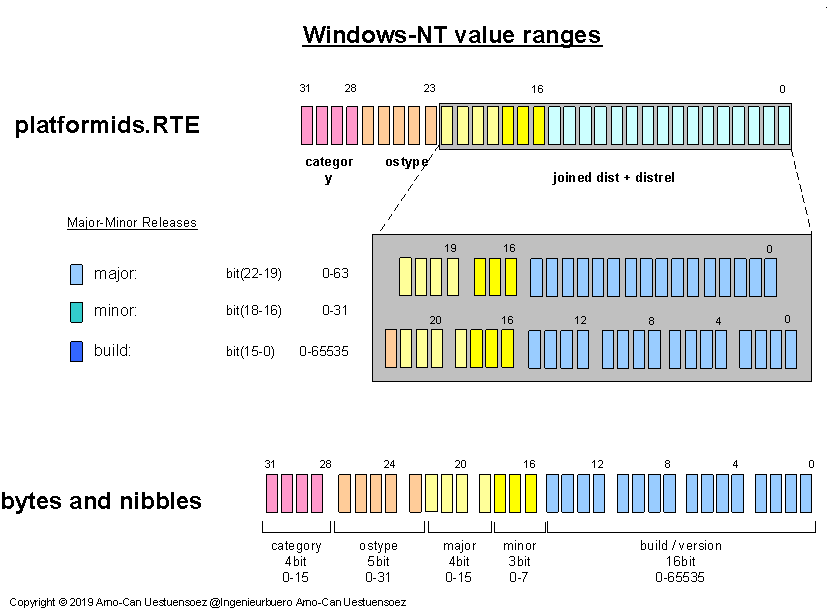
Figure: Windows NT Enconding  ¶
¶
The mathematical characteristict of the order relations for the old and new pure numeric representation still remain and are applicable e.g. on combined values.
( RTE_NT61 < RTE_NT100 ) is True
This assures the fast bitwise access to the complete range of version numbers for all releases. The following layout example depicts the release versions of ‘Windows 7 Ultimate’ and ‘Windows 10 Professional’:
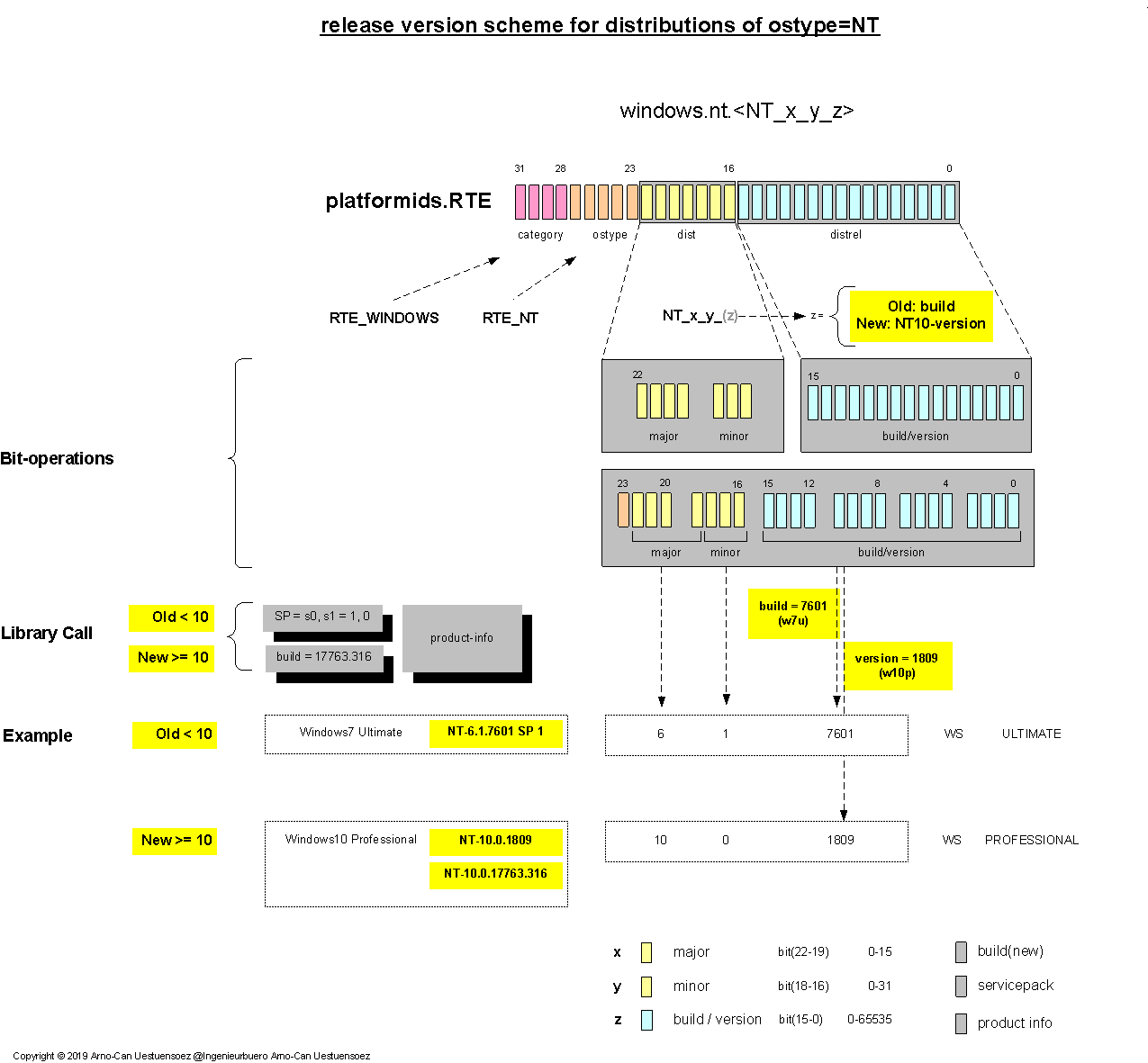
Figure: Windows NT Releases  ¶
¶
When specific distinction in relation to the service packs or intermediate preview-build or update-builds is required, the complete build id or service pack identifier has to be evaluated. Another point is the packaged product type, which is to behandled by the library interface. E.g. the distinction of WORKSTATION, SERVER, PROFESSIONAL, etc.
The platformids therefore provides the 32bit numeric vector for fast and efficient release version only based processing, alternatively the class platformids.platforms.PlatfromParameters for the complete set of possible parameters on each platform, but with resulting additional processing of course.
For the required defines of Windows-NT see windows.py, for ReactOS see reactos.py.
Some numbering examples are:
release
build
distrel
product-type
product-map
test-status
specials
NT-10.0.1806
10.0.17134.316
OK
scheme nt-scheme
NT-10.0.1806
10.0.17134
OK
scheme nt-scheme
NT-10.0.1607
10.0.14393.2670
OK
scheme nt-scheme
NT-10.0.1809
10.0.17763.195
OK
scheme nt-scheme
NT-10.0.1809
10.0.17763.195
OK
scheme nt-scheme
NT-6.3.9600
9600
OK
scheme nt-scheme
NT-6.3.9600
9600
OK
scheme nt-scheme
NT-6.1.7601
7601
OK
scheme nt-scheme
NT-6.1.7601
7601
OK
scheme nt-scheme
NT-6.1.7601
7601
OK
scheme nt-scheme
NT-5.1.2600
2600
scheme nt-scheme
release:
The actual numbering and name of an released package.
build:
The public reference to a packaged distribution.
distrel:
The public name of the distributed product.
product-type:
The categories defined by Microsoft.
OSVERSIONINFOEXA.wProductType
product-map:
The released products defined by Microsoft
OSVERSIONINFOEXA.wSuiteMask
are remapped to a more abstract and reduced proprietary map.
platformids.dist.windows.prod_type_categories
The map defines the following values:
prod_type_categories = ( "H", # 0: Home "HS", # 1: Home Server "WS", # 2: Workstation "D", # 3: Data Center "E", # 4: Enterprise Server "STD", # 5: Standard Server "BS", # 6: Basic Server: Small Business Server / Essential Server "VIRT", # 7: Virtualization "EMB", # 8: Embedded / IoT "EDU", # 9: Education )
These values are mapped from the result of the API ‘GetProductInfo’ by the mapping of the resulting values:
prod_ext = { 0x00000006: 8, # PRODUCT_BUSINESS 0x00000012: 8, # PRODUCT_CLUSTER_SERVER 0x00000065: 8, # PRODUCT_CORE 0x00000050: 3, # PRODUCT_DATACENTER_EVALUATION_SERVER 0x00000008: 3, # PRODUCT_DATACENTER_SERVER 0x0000000C: 3, # PRODUCT_DATACENTER_SERVER_CORE 0x00000027: 3, # PRODUCT_DATACENTER_SERVER_CORE_V 0x00000025: 3, # PRODUCT_DATACENTER_SERVER_V # # ... for the full list refer to platformids.dist.windows.prod_ext # }
5.10.1.1. New Version Paradigm¶
The Windows10 release is announced by Microsoft to be the last Windows version, which is from than on an OS as a service. The consequence is a versionless paradigm of continuous short-term updates - but implemented pragmatically with extended release channels of longer periods for commercial and critical infrastructures.
The following lists - just a quoted - short excerpt from the new versionless continuous development and deployment of the Windows10 ‘OS as a service’ - OaaS for the PC version. The resulting practical definition of the term ‘version’ is a constant part 10.0 extended by the variable date based third number.
Note
The current versions-of-windows10-versions at the time of writing are, see [WIN10VERSIONS].
1 Rings 2 PC version history 2.1 Version 1507 2.2 Version 1511 (November Update) 2.3 Version 1607 (Anniversary Update) 2.4 Version 1703 (Creators Update) 2.5 Version 1709 (Fall Creators Update) 2.6 Version 1803 (April 2018 Update) 2.7 Version 1809 (October 2018 Update) 2.8 Version 1903 2.9 Codename 19H2 2.10 Codename 20H1 3 Mobile version history ...
For the detailed life cycle of the current versions refer to the updated ‘Windows lifecycle fact sheet’ [WIN10LIFECYCLE]. For the complete table of the following extract see the version definitions [WIN10VERSIONS] - Section ‘1 Rings’.
Version
Codename
Release date
Latest build
PC
Mobile
1507
Threshold 1
July 29, 2015
10240
N/A
1511
Threshold 2
November 10, 2015
10586
10586
1607
Redstone 1
August 2, 2016
14393
14393
1703
Redstone 2
April 5, 2017
15063
15063
1709
Redstone 3
October 17, 2017
16299
15254
1803
Redstone 4
April 30, 2018
17134
N/A
1809
Redstone 5
November 13, 2018
17763
N/A
1903
19H1
TBA
18348
N/A
TBA
19H2
TBA
N/A
N/A
TBA
20H1
TBA
18845
N/A
Each version of the ‘NT-10.0’ release is continuously updated in accordance to it’s lifecycle plan [WIN10LIFECYCLE] by continuous build steps. The following example of the ‘Public patches of Windows 10 version 1809’ [WIN10VERSIONS] displays the complete version number and product name with the binding to the complete build number.
10.0.17763.1 == Windows 10 - 1809 - Release preview and public release: October 2, 2018 10.0.17763.17 == Windows 10 - 1809 - KB4467228 - Slow ring and release preview: October 9, 2018 10.0.17763.55 == Windows 10 - 1809 - KB4464330 - Slow ring, release preview and public release: October 9, 2018
The name-part Slow ring binds the update scheme in accordance to the update channel [WIN10LIFECYCLE]. For the complete list of the following extract refer to Wikipedia [WIN10VERSIONS].
Public patches of Windows 10 version 1809
Version
Knowledge base
Release date(s)
10.0.17763.1
Release preview and public release:
October 2, 2018
10.0.17763.17
KB4467228
Slow ring and release preview:
October 9, 2018
10.0.17763.55
KB4464330
Slow ring, release preview and public release:
October 9, 2018
…
…
…
10.0.17763.316
KB4487044
Slow ring, release preview and public release:
February 12, 2019
…
…
…
Examples for the output of the ver.exe command are:
old: Windows7-Ultimate: Microsoft Windows [Version 6.1.7601] new: Windows10-Professional: Microsoft Windows [Version 10.0.17763.316]
5.10.1.2. Implemented Version Scheme and processing¶
The new version scheme, which has to be provided as a seamless integrated scheme with the old schemes, opens some challenges for the bitmask representation by a 32bit value. This in particular is not possible by direct copy of the partial values because each componen itself is in most cases 64bit wide. Even though the value ranges are used really sparse.
To remember, the main target of the implementation by platformids is the support of a numeric value for fast and efficient comparison operations. Thus the provided 32bit value, which could contain a compressed representation of the complete version only, has still to provide an accurate order criteria.
Even though the possibility to address specific releases is enhanced, for the developer it may become more difficult to keep track of all pre-required changes.
The current changes of the NT10_0 release versioning scheme - which seem to be an intermediate step to… - basically break the numbering scheme of any other distribution. This is not handsome when it comes to unify the version schemes for heterogenous cloud environments into one common library. The platformids handles this by introducing optional custom callbacks for non-standard OS distributions. The additional handling degrades the processing for these non-standard-custom version schemes, thus should be cached in case of large loops.
5.10.1.3. Build Identifiers¶
The appropriate runtime identifier for the new build enumeration starting with NT.10.0 extended by the build id.
will be available soon
5.10.1.4. Implementation¶
The actual core implementation for the Windows NT platform is naturally based on the Windows-Registry, which is supported by the standard libraries winreg [WINREG3] and _winreg [WINREG2] . Due to the lack of availability on the standard platforms in two cases some special solutions are required.
For details refer to the Windows module platformids.dist.windows.
5.10.1.5. Windows NT Registry¶
The main source for the acquisition of the information is is finally chosesn as the registry. This is not as trivial as it sounds because this includes the complete range of the Python implementations, so Jython, and the the implementation of the platform Cygwin. Both by default do not provide the standard library winreg/_winreg, which is used else.
The next challange is the frequent change of the registry keys, thus the platformids provides a canonical representation for all supported WindowsNT releases beginning with NT4_0.
The standard key
HKEY_LOCAL_MACHINE\SOFTWARE\Microsoft\Windows NT\CurrentVersion
provides basically two main variants of the key, the pre-NT-10 and the NT-10-and-later. Both variants offer different sets of attributes for the required platform information. For details refer to the Windows module platformids.dist.windows.
key
NT4_0
NT5_0
NT5_1
ReactOS5_2
NT6_1
NT6_1
NT6_3
NT6_3
NT10_0
1381
2195
2600
3790
7601
7601
9600
9600
1511
1809
1607
1809
nt40
w2000
wxp
ReactOS
w2008r2
w7
w2012r2
w8.1
w10IoT
w10
w2016
w2019
BuildBranch
x
x
x
x
BuildGUID
x
x
x
x
x
x
x
x
BuildLab
x
x
x
x
x
x
x
x
x
x
BuildLabEx
x
x
x
x
x
x
x
x
CompositionEditionID
x
x
x
CSDBuildNumber
x
x
x
CSDVersion
x
x
x
x
x
x
CurrentBuild
x
x
x
x
x
x
x
x
x
x
x
x
CurrentBuildNumber
x
x
x
x
x
x
x
x
x
x
x
x
CurrentMajorVersionNumber
x
x
x
x
CurrentMinorVersionNumber
x
x
x
x
CurrentType
x
x
x
x
x
x
x
x
x
x
x
CurrentVersion
x
x
x
x
x
x
x
x
x
x
x
x
DigitalProductId
x
x
x
x
x
x
x
x
x
DigitalProductId4
x
x
x
x
x
x
x
EditionID
x
x
x
x
x
x
x
x
EditionSubManufacturer
x
x
EditionSubVersion
x
x
EditionSubstring
x
x
InstallDate
x
x
x
x
x
x
x
x
x
x
x
x
InstallTime
x
x
x
InstallationType
x
x
x
x
x
x
x
x
LicenseInfo
x
PathName
x
x
x
x
x
x
x
x
x
x
x
ProductId
x
x
x
x
x
x
x
x
x
x
ProductName
x
x
x
x
x
x
x
x
x
x
x
x
RegDone
x
x
x
x
x
RegisteredOrganization
x
x
x
x
x
x
x
x
x
x
x
RegisteredOwner
x
x
x
x
x
x
x
x
x
x
ReleaseId
x
x
x
x
SoftwareType
x
x
x
x
x
x
x
x
x
x
x
x
SourcePath
x
x
x
SubVersionNumber
x
SystemRoot
x
x
x
x
x
x
x
x
x
x
x
x
UBR
x
x
x
x
x
x
The access to the windows registry is provided by multiple interfaces, this is due to the circumstances, that the API of the standard libs has changed from _winreg to winreg. The Jython implementation is missing this library completely in companion with others, thus the Jython implementation of the registry access is provided by a Java module.
- Python
The Python implementations CPython, IPython, IronPython, and PyPy support the interface of the standard libraries
For further infocmation refer to Data Acquisition, and Python.
With the exception of the standard Cygwin port of CPython see Cygwin.
- Java for Jython
The Jython implementation as of until Jython-2.7.1 does not support registry access for Windows. Thus this has to be implemented by one of the alternatives via a Java module. The standar data provided by System is a bit too less.
For further infocmation refer to Data Acquisition, and Jython.
- Windows NT SDK
The windws NT SDK defines some product specific macros which pose similar values as the RTE as Macros for Conditional Declarations [MACROSRELCOND]. These define a subset of the RTE within the context domain of platformids.RTE_NT. The macros focus on the legacy NT versions, but include for those the SP information.
5.10.1.6. Windows NT API¶
The system information data of the NT platform is acquired by calling the system libraries interfaces mainly provided by kernel32.dll. The calls are implemented as ctypes in the module platformids.dist.nt.windows_kernel32_dll.py and platformids.dist.nt.windows_products.py .
5.10.2. NT Product Types¶
The version numbering scheme is the same for all relevant Windows versions. The identical versions are assigned to a specific evolution step of all products, thus require additional product information in order to detemine a specific runtime environment. Therefore the platformids provides the product identification as a seperate numeric value for the supported types.
PC and Server Platforms
The historic domain of the NT technology is the server based computing, later the field of profesional worksattions, and finally all PC and server platforms.
Embedded or IoT Platforms
The classical embedded devices with limited resources, in nowadays of the definition of ‘limited’ it is the cloud based IoT. The distinction is here no longer sharp, because the IoT variants are operated on devices such as full scale Atom or ARM based devices which include memory management and an architecture, which would have been just a few years ago a full scale professional workstation.
The windows module supports a transparently mapped interface to the system libraries, thus the full scope of the provided data is available when required. For the fast processing similar to the bitmask vector of the distribution a numeric value is supported. Due to the amount of defined products, this still could require some resources, thus is designed in three of abstraction levels.
The default interface for the windows environment suppors a high level distinction of the abstract types based on the values presented by the OSVERSIONINFOEXA.wProductType:
server
workstation
domain comtroller
In addition the value for the IoT variants is added by the platformids.
platformids.basetype = ( 1 # VER_NT_WORKSTATION # defined by wProductType | 2 # VER_NT_DOMAIN_CONTROLLER # defined by wProductType | 3 # VER_NT_SERVER # defined by wProductType | 4 # VER_NT_IOT # defined by platformids )
The next level of abstraction is the transparent pass of the values from the interface parameter wProductType, which defines detailed values for all products. This is available when the module platfomrids.dist.windows_products is loaded.
platformids.product = ( 0x00000006 # PRODUCT_BUSINESS | 0x00000010 # PRODUCT_BUSINESS_N | 0x00000012 # PRODUCT_CLUSTER_SERVER | 0x00000040 # PRODUCT_CLUSTER_SERVER_V | 0x00000065 # PRODUCT_CORE # # ...see platformids.dist.windows_products # )
The module ‘platformids.dist.windows_products’ supports in addition a medium level technical abstraction by the mapping of the product ids:
prod_type_categories = ( "H", # 0: Home "HS", # 1: Home Server "WS", # 2: Workstation "D", # 3: Data Center "E", # 4: Enterprise Server "STD", # 5: Standard Server "BS", # 6: Basic Server: Small Business Server / Essential Server "VIRT", # 7: Virtualization "EMB", # 8: Embedded / IoT "EDU", # 9: Education )
The most detailed level is available when the system interfaces of the transparent calls as provided by platformids.dist.windows are applied.
get_win32_IsWindowsXPSP1OrGreater() get_win32_OSProductInfo() get_win32_OSVersionInfo() get_win32_OSVersionInfoExa() print_versinfo(vinfo)
These transparently pass the compelete data structure provided by the system libraries.
5.10.3. NT-Releases¶
For predefined values refer to windows.py. Some examples are
release
Product
version and bitmask
build
version
RTE
NT-10.0.1809
0x20d00711
10.0.17763.136
Windows 10 Professional
NT-10.0.1803
0x20d0070b
10.0.17134.619
Windows 10 Home
NT-10.0.1809
0x20d00711
10.0.17763.136
Windows 2016 Server
NT-10.0.1809
0x20d00711
10.0.17763.195
Windows 2019 Server Essentials
NT-10.0.1809
0x20d00711
10.0.17763.253
Windows 2019 Server
NT-6.3.9600
0x20b32580
9600
Windows 2012R2 Server
NT-6.1.7601
0x20b11db1
7601
Windows 7 Ultimate
NT-6.1.7601
0x20b11db1
7601
Windows 7 Professional
NT-6.1.7601
0x20b11db1
7601
Windows 2008R2 Server
NT-5.1.2600
0x20a90a28
2600
Windows XP 32bit
5.10.3.1. NT-10.0¶
The encoding for NT-10.0 releases consists of the base value RTE_NT100 and the numeric release version as the 4digit value of the ‘<year-month>’. The following figure details the calculation for the version 1809, which represents the first release of the version at 2018.09.
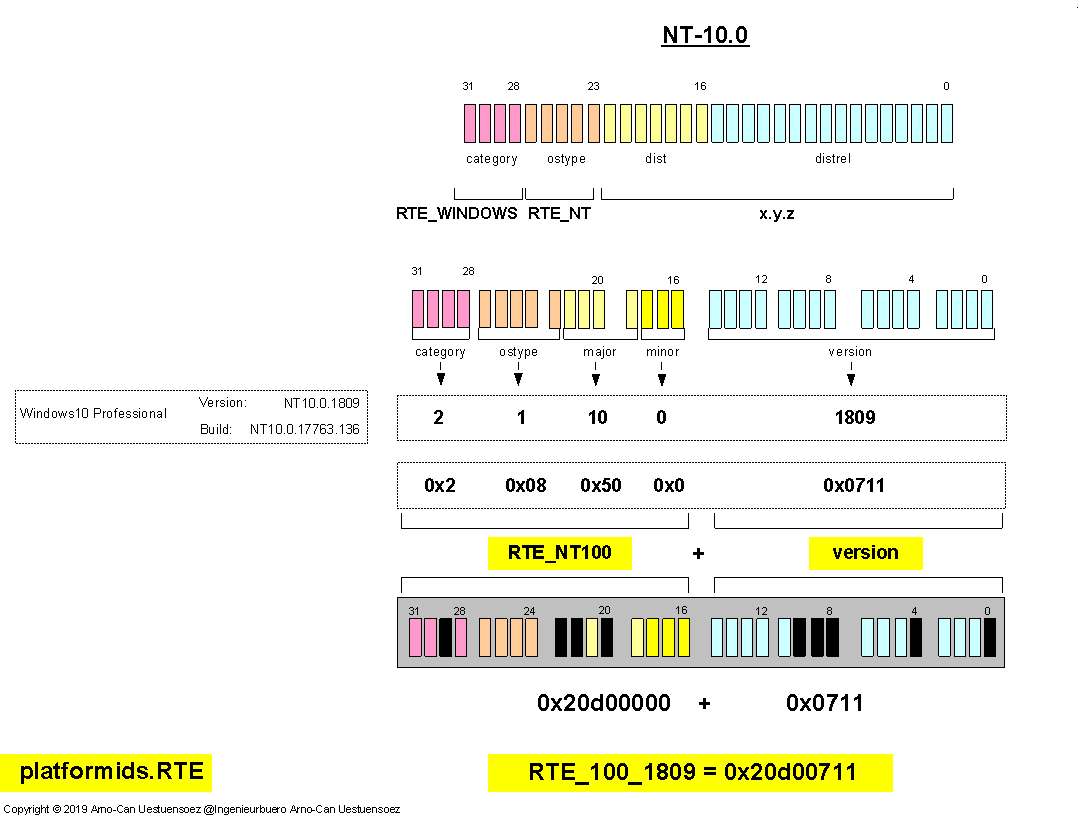
Figure: Windows NT-10.0 Enconding  ¶
¶
The release information of NT-10.0 comprises currently the Windows-10, the Server-2016, and the Server-2019 families. For product types refer to windows_products.py.
type
enum
string
remarks
category
RTE_WIN
windows
ostype
RTE_NT
nt
dist
RTE_NT100
nt100
distrel
see [WINVERSIONS], scheme nt-scheme
pretty
NT-10.0
5.10.3.2. NT-6.3¶
The version of the product contains here the actual build number, which is an arbitrary incremented value. The value therefore has the double semantics as beeing the build counter at the time of the product release, and as the micro version number for the products lifetime. The same is true for all previous versions of NT.
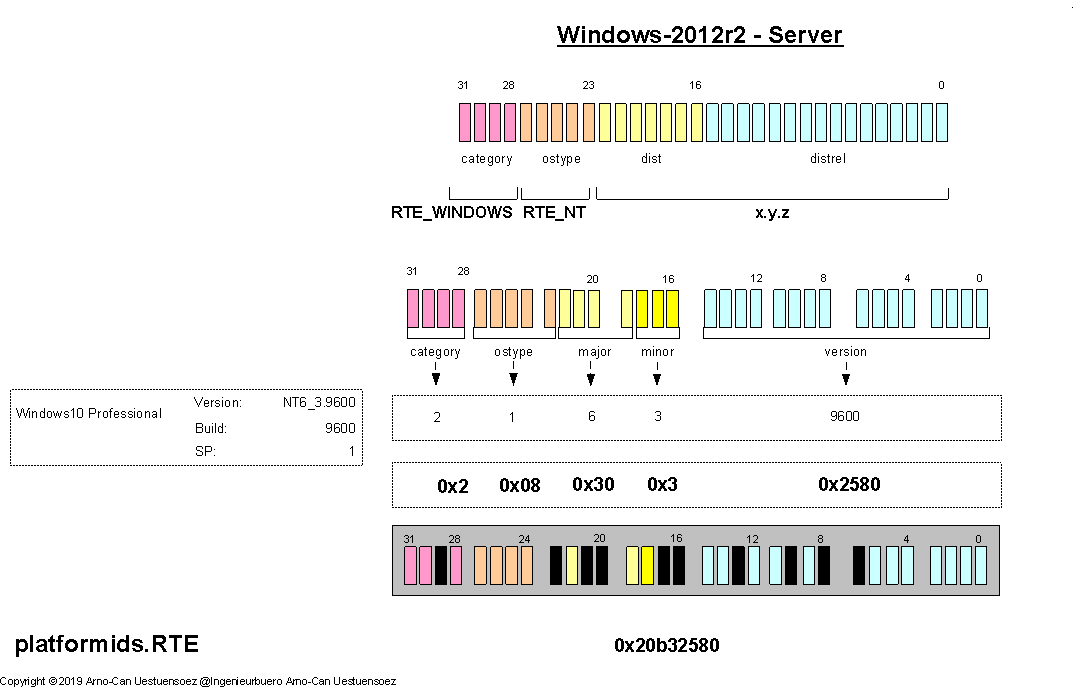
Figure: Windows NT-6.3 Enconding  ¶
¶
NT-6.3 comprises Windows-8 and the Server 2012 famlies.
type
enum
string
remarks
category
RTE_WIN
windows
ostype
RTE_NT
nt
dist
RTE_NT63
nt63
distrel
see windows.py
see [WINVERSIONS], scheme nt-scheme
pretty
NT-6.3
5.10.3.3. NT-6.1¶
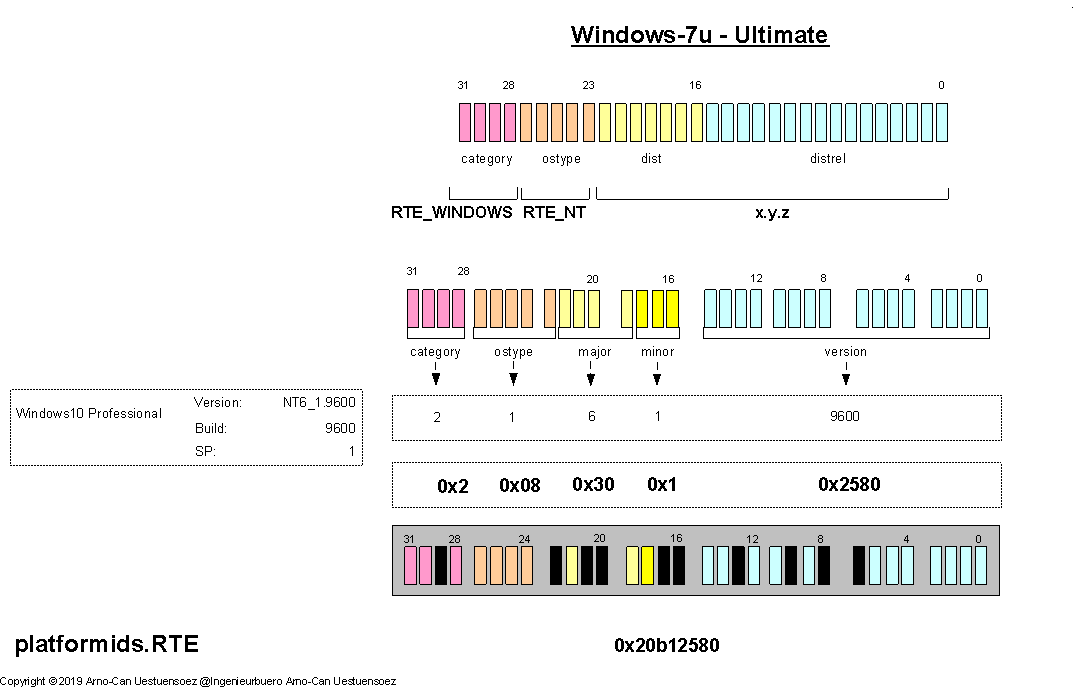
Figure: Windows NT-6.1 Enconding  ¶
¶
NT-6.1 comprises Windows-7 and the Server 2008 famlies.
type
enum
string
remarks
category
RTE_WIN
windows
ostype
RTE_NT
nt
dist
RTE_NT61
nt61
distrel
see windows.py
see [WINVERSIONS], scheme nt-scheme
pretty
NT-6.1
5.10.3.4. NT-5.1¶
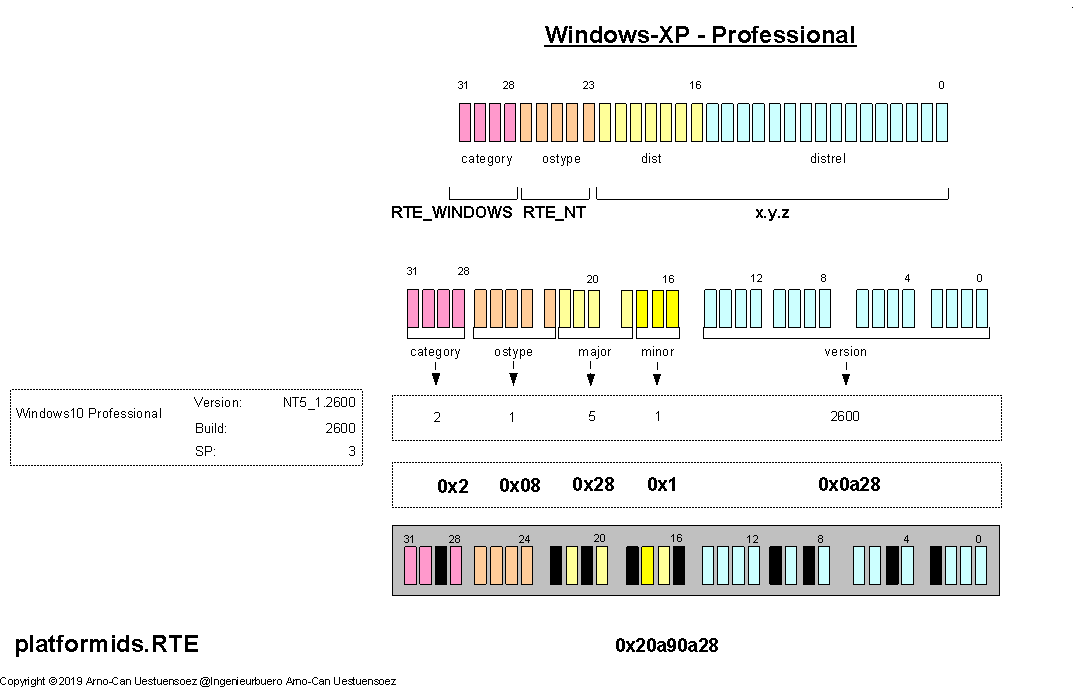
Figure: Windows NT-5.1 Enconding  ¶
¶
NT-5.1 comprises Windows-XP and the Server 2003 famlies.
type
enum
string
remarks
category
RTE_WIN
windows
ostype
RTE_NT
nt
dist
RTE_NT51
nt51
distrel
see windows.py
see [WINVERSIONS], scheme nt-scheme
pretty
NT-5.1
5.11. Security and Network Systems¶
The current actively supported and tested embedded and alternate architectures of OS and distributions are listed in the following table, where the tests are by default based on CPython or MicroPython only. Where available the complete set of supported Python implementations as defined by pythonids [pythonids] is tested.
More distributions are supported generically, but not explicitly tested by the author.
category
ostype
dist
tested distrel
doc
test status
PC
VM
RaspberryPI
Asus
Linksys
Zyxel
1
2
3
Z
TinkerBoard
WRT-1900
WPA-3205
RTE_POSIX
RTE_BSD
RTE_PFSENSE
–
–
–
–
–
–
–
RTE_OPENBSD
6.4
OK
OK
–
*
–
–
–
–
RTE_LINUX
RTE_KALI
2018.4+
OK
*
*
*
–
–
–
–
2019.1+
OK
*
*
*
–
–
–
–
RTE_OPENWRT
17.01.6
OK
*
*
*
*
–
*
18.06.1
OK
*
*
*
*
–
OK
OK
Custom Examples
category
ostype
dist
tested distrel
doc
test status
PC
VM
RaspberryPI
Asus
Linksys
Zyxel
1
2
3
Z
TinkerBoard
WRT-1900
WPA-3205
RTE_POSIX
RTE_LINUX
RTE_BLACKARCH
OK
OK
*
*
*
–
–
–
–
RTE_POSIX
RTE_LINUX
RTE_PARROTOS
OK
OK
–
*
*
–
–
–
–
RTE_POSIX
RTE_LINUX
RTE_PENTOO
OK
OK
–
–
–
–
–
–
–
5.11.1. Security Tools¶
5.11.1.1. KaliLinux¶
Kali Linux is derived from BackTrack Linux. Kali Linux has changed it’s distribution versioning scheme to rolling releases [RollingDist], and finally a build-cycle period of 1 week.
since 2016-Week11 / 2016.3.11 weekly image releases beginning with 2016.3.11, current is Kali 2019.W11 – 11th March, 2019.
since 2016 rolling releases beginning with 2016.1, current is Kali 2019.1 – 18th February, 2019.
Kali 2.x 2015
Kali 1.x.y 2013-2015
For the module description refer to platformids.net.kali-Linux.
The applied scheme is 3num-date, where the first number is the year of the release, the week is converted to the monday of the week. The offset for KaliLinux is the standard offset unixtime 1970.1.1:
type
enum
string
remarks
category
RTE_POSIX
posix
ostype
RTE_LINUX
linux
dist
RTE_KALILINUX
kalilinux
distrel
see kali.py
see [KALILINVERSIONS], scheme 3num-date
pretty
Kali Linux
The version is set in the file ‘/etc/os-releases’ by the attribute VERSION, which is evaluated and processed to a date by the platformids.
Examples for the Kali Linux ISO file production naming are:
kali-linux-2019-W11-amd64.iso kali-linux-2019.1-amd64.iso
The following example shows the encoding for the runtime environment of ArchLinux
Resulting in the bitmask:
or the final encoding for the default offset of the year 1970.1.1:
See kali.py
5.11.2. Network Nodes¶
5.11.2.1. OpenBSD¶
For the module description refer to OpenBSD.
type
enum
string
remarks
category
RTE_POSIX
posix
ostype
RTE_BSD
bsd
dist
RTE_OPENBSD
openbsd
distrel
see openbsd.py
see [OPENBSDVERSIONS], schema default
pretty
OpenBSD
The applied encoding is here the default pattern.
Examples are:
openbsd-6.2 openbsd-6.3 openbsd-6.4
See openbsd.py
5.11.2.2. OpenWRT¶
For the module description refer to platformids.net.openwrt.
type
enum
string
remarks
category
RTE_POSIX
posix
ostype
RTE_LINUX
linux
dist
RTE_OPENWRT
openwrt
distrel
see openwrt.py
see [OPENWRTVERSIONS], schema default
pretty
OpenWRT
The OpenWRT [OPENWRT] OS is a Linux derivative for WiFi devices.
The applied encoding is here the default pattern.
The current versions at the time of writing are:
OpenWRT-17.01.6 OpenWRT-18.06.1
The provided value ranges are:
<major><minor><build>
17.01.6
major : 5-bits -> 0..31 - current: 17
minor : 5-bits -> 0..31 - current: 1
index : 5-bits -> 0..31 - current: 6
18.06.1
major : 5-bits -> 0..31 - current: 18
minor : 5-bits -> 0..31 - current: 6
index : 5-bits -> 0..31 - current: 1
See openwrt.py
5.11.2.3. pfSense¶
For the module description refer to pfSense.
type
enum
string
remarks
category
RTE_POSIX
posix
ostype
RTE_BSD
bsd
dist
RTE_PFSENSE
pfsense
distrel
see pfsense.py
schema default
pretty
Pfsense
5.12. Embedded Systems and IoT¶
The main design target of the platformids is to support information about runtime environments including cross platform information for other targets within heterogeneous IT landscapes of clouds. The primary targeted resources are physical and virtual general purpose servers and workstations.
The introduction of interconnected small devices in particular in conjunctio with the IoT [IOT] provides heterogenous devices with limited runtime resources. For typical embedded systems [EMBEDSYS] with limited resources and specialized OS variants [EMBEDOS] the platformids supports the installation of reduced module providing the API,
A considerable number of embedded systems actually represent a full scale general purpose PC like platform as a shrinked device with additional direct access to specialized hardware components.
The definition of embedded devices within the scope of the platformids contains two aspects,
support of full scale genral purpose operating systems on shrinked devices:
frequently mobile handheld devices, e.g. Android, or Raspbian based appliances including the prototyping and DIY hobbiest maker segments
adapted general purpose OS on complex devices, for example Linux on network devices as OpenWRT and Kali Linux
actual specialized embedded systems with support for Python
e.g. MicroPython and CircuitPython as basic control software for programmable tiny controller chips
The current actively supported and tested embedded and alternate architectures of OS and distributions are listed in the following table, where the tests are by default based on CPython or MicroPython only. Where available the complete set of supported Python implementations as defined by pythonids [pythonids] is tested.
More distributions are supported generically, but not explicitly tested by the author.
category
ostype
dist
tested distrel
doc
test status
PC
VM
RaspberryPI
Asus
Linksys
Zyxel
1
2
3
Z
TinkerBoard
WRT-1900
WPA-3205
RTE_POSIX
RTE_BSD
RTE_PFSENSE
–
–
–
–
–
–
–
RTE_OPENBSD
6.4
OK
OK
–
*
–
–
–
–
RTE_LINUX
RTE_KALI
2018.4+
OK
*
*
*
–
–
–
–
2019.1+
OK
*
*
*
–
–
–
–
RTE_OPENWRT
17.01.6
OK
*
*
*
*
–
*
18.06.1
OK
*
*
*
*
–
OK
OK
Custom Examples
category
ostype
dist
tested distrel
doc
test status
PC
VM
RaspberryPI
Asus
Linksys
Zyxel
1
2
3
Z
TinkerBoard
WRT-1900
WPA-3205
RTE_POSIX
RTE_LINUX
RTE_BLACKARCH
OK
OK
*
*
*
–
–
–
–
RTE_POSIX
RTE_LINUX
RTE_PARROTOS
OK
OK
–
*
*
–
–
–
–
RTE_POSIX
RTE_LINUX
RTE_PENTOO
OK
OK
–
–
–
–
–
–
–
The platformids supports the cases as described by the following sections.
5.12.1. Embedded POSIX-OS¶
The large scale embedded systems even available for the consumer market like the RaspberryPI represents a class of embedded systems which provide basically a full scale general purpose PC and even server platform including memory management. It adds by definition interfaces for the access to lower level open hardware interfaces.
The provided POSIX OS, which are currently almost all OpenSource, add libraries with interfaces for the standard access to the lower level HW interfaces. Thus these OS still remain ‘literally’ a full scale OS with formally the complete feature set available, just restricted by eventual physical resource limits. This is also the case for the various alternate platforms such as ARM builds e.g. in the case of a typical server OS CentOS-altarch, which is basically ‘literally’* ported.
This is supported by platformids from the box.
5.12.1.1. Alpine Linux on ARM¶
For the module description refer to platformids.dist.alpinelinux.
type
enum
string
remarks
category
RTE_POSIX
posix
ostype
RTE_LINUX
linux
dist
RTE_ALPINE
alpinelinux
distrel
see alipine.py
see [ALPINEVERSIONS], scheme default
pretty
AlpineLinux
The value ranges and incremental behaviour fit into the standard scheme. The AlpineLinux distribution uses the default versioning scheme. For the numbering scheme refer to AlpineLinux. See also alpinelinux.py
5.12.1.2. Arch Linux ARM¶
For the module description refer to platformids.dist.archlinux.
type
enum
string
remarks
category
RTE_POSIX
posix
ostype
RTE_LINUX
linux
dist
RTE_ARCHLINUX
archarm
distrel
see archlinux.py
pretty
Arch Linux ARM
The Arch Linux distribution [ARCHLIN] is based on the Rolling Release philosophy [RollingDist]. Therefore it virtually supports one release over it’s life cycle with frequent small fixes and updates. For the numbering scheme refer to the standard distribution ArchLinux. See also Arch Linux.py
5.12.1.3. Armbian¶
For the module description refer to platformids.embed.armbian.
type
enum
string
remarks
category
RTE_POSIX
posix
ostype
RTE_LINUX
linux
dist
RTE_ARMBIAN
armbian
distrel
see armbian.py
see [ARMBIANVERSIONS], scheme 3-number-minor-ext
pretty
Armbian
The distribution Armbian is closely based on debian and targets a large number of ARM boards [ARMBIAN]. The numbering scheme of debian is physically available, but replaced by an own numbering scheme for the representation of the significantly higher number of build targets. The resulting scheme is represented as the modified standard pattern for a 2-number version. Examples for the Asus-TinkerBoard are:
armbian-4.81 / 28.12.2015 armbian-5.50 / 28.6.2018 armbian-5.76 / 11.2.2019
As depicted, the minor version number hits already large values compared to the other standard distributions, which mainly do not use minor numbers higher than 10-15.
The applied encoding is here the standard pattern for a 2-number version with modified ranges for the minor and major version numbers.
major number: 0-15
minor number: 0-255
Thus it could be expected to last at least for the next decades.
The following example shows the encoding for the runtime environment of Armbian-5.50
Resulting in the bitmask:
or the final encoding
See armbian.py
5.12.1.4. CentOS AltArch¶
For the module description refer to platformids.dist.centos.
type
enum
string
remarks
category
RTE_POSIX
posix
ostype
RTE_LINUX
linux
dist
RTE_CENTOS
centos
distrel
see centos.py
see [CENTOSVERSIONS], scheme default
pretty
CentOS
The distribution CentOS has changed it’s numbering scheme slightly beginning with the release CentOS7 [CENTOS]. For the numbering scheme refer to the standard distribution CentOS. See centos.py
5.12.1.6. Raspbian¶
For the module description refer to platformids.embed.raspbian.
type
enum
string
remarks
category
RTE_POSIX
posix
ostype
RTE_LINUX
linux
dist
RTE_RASPBIAN
raspbian
distrel
see raspbian.py
see [RASPBIANVERSIONS], schema default
pretty
Raspbian
The distribution Raspbian is closely based on debian and targets the RaspberryPI HW platform only. The applied encoding is here the standard pattern for a 2-number version. Examples are:
raspbian-9.3 raspbian-9.4
The applied encoding is here the default pattern.
See raspbian.py
5.12.1.7. FreeBSD/ARM¶
For the module description refer to platformids.dist.freebsd.
type
enum
string
remarks
category
RTE_POSIX
posix
ostype
RTE_BSD
bsd
dist
RTE_FREEBSD
freebsdarm
distrel
see freebsd.py
see [FREEBSDVERSIONS], schema default
pretty
FreeBSD/ARM
The distribution FreenBSD [FREEBSD] applies the standard pattern for a 2-number version. For the numbering scheme refer to the standard distribution FreeBSD. See also freebsd.py
5.12.1.8. NetBSD/ARM¶
For the module description refer to platformids.dist.netbsd.
type
enum
string
remarks
category
RTE_POSIX
posix
ostype
RTE_BSD
bsd
dist
RTE_NETBSD
netbsdarm
see [NETBSDVERSIONS], schema default
distrel
see netbsd.py
pretty
NetBSD/ARM
For the numbering scheme refer to the standard distribution NetBSD. See also netbsd.py.
5.12.1.9. OpenBSD Arm64¶
For the module description refer to platformids.dist.openbsd.
type
enum
string
remarks
category
RTE_POSIX
posix
ostype
RTE_BSD
bsd
dist
RTE_OPENBSD
openbsd
distrel
see openbsd.py
see [OPENBSDVERSIONS], schema default
pretty
OpenBSD
For the numbering scheme refer to the standard distribution OpenBSD. See also openbsd.py
5.12.1.10. Slackware/ARM¶
type
enum
string
remarks
category
RTE_POSIX
posix
ostype
RTE_LINUX
linux
dist
RTE_SLACK
slackware
distrel
see slackware.py
[SLACKVERSIONS], schema default
pretty
Slackware
The distribution Slackware applies the standard pattern for a 2-number version, while the actual release schedule is state-driven [SLACKWARE]. For the numbering scheme refer to the standard distribution Slackware. See also slack.py
5.12.2. Embedded Windows¶
The things are slightly different for the actually embedded variant of Windows NT or NT
5.12.2.1. Windows-10-IoT on RaspberryPI¶
The IoT runtime environment of WindowsNT, which is from the parallel release of Windows NT-10.0 on named as Windows 10 IoT. The IoT OS offers the look and feel similar to the full scale OS on PC based platforms. This includes for example the following similar registry structure and values including the NT specific release version and build numbering scheme:
HKEY_LOCAL_MACHINESOFTWAREMicrosoftWindows NTCurrentVersion SystemRoot REG_SZ C:windows BuildBranch REG_SZ rs5_release_svc_prod2 BuildGUID REG_SZ ffffffff-ffff-ffff-ffff-ffffffffffff BuildLab REG_SZ 17763.rs5_release_svc_prod2.181026-1406 BuildLabEx REG_SZ 17763.107.armfre.rs5_release_svc_prod2.181026-1406 CurrentBuild REG_SZ 17763 CurrentBuildNumber REG_SZ 17763 CurrentMajorVersionNumber REG_DWORD 0xa CurrentMinorVersionNumber REG_DWORD 0x0 CurrentType REG_SZ Multiprocessor Free CurrentVersion REG_SZ 6.3 EditionID REG_SZ IoTUAP InstallationType REG_SZ IoTCore InstallDate REG_DWORD 0x0 ProductName REG_SZ IoTUAP ReleaseId REG_SZ 1511 SoftwareType REG_SZ System UBR REG_DWORD 0x6b
The workstation platform of Windows 10 Professional for example has basically the same core structure of registry entries for the key with additional attributes and sub keys. Thus for a user it is easy to navigate the core components by common procedures on the whole scope of platforms.
HKEY_LOCAL_MACHINESOFTWAREMicrosoftWindows NTCurrentVersion SystemRoot REG_SZ C:WINDOWS BuildBranch REG_SZ rs5_release BuildGUID REG_SZ ffffffff-ffff-ffff-ffff-ffffffffffff BuildLab REG_SZ 17763.rs5_release.180914-1434 BuildLabEx REG_SZ 17763.1.amd64fre.rs5_release.180914-1434 CompositionEditionID REG_SZ Enterprise CurrentBuild REG_SZ 17763 CurrentBuildNumber REG_SZ 17763 CurrentMajorVersionNumber REG_DWORD 0xa CurrentMinorVersionNumber REG_DWORD 0x0 CurrentType REG_SZ Multiprocessor Free CurrentVersion REG_SZ 6.3 EditionID REG_SZ Professional EditionSubManufacturer REG_SZ EditionSubstring REG_SZ EditionSubVersion REG_SZ InstallationType REG_SZ Client InstallDate REG_DWORD 0x5c148e47 ProductName REG_SZ Windows 10 Pro ReleaseId REG_SZ 1809 SoftwareType REG_SZ System UBR REG_DWORD 0x13c PathName REG_SZ C:Windows ProductId REG_SZ 00330-71368-98807-AAOEM DigitalProductId REG_BINARY A... DigitalProductId4 REG_BINARY F... RegisteredOrganization REG_SZ RegisteredOwner REG_SZ acue InstallTime REG_QWORD 0x1d49435652218c3
The product family of embedded OS variants is actually primarily targeting to provide the interface only for commercial customers as a platform for closed appliances. It’s major part of implementation may be consequently different than the mainstream OS - as simply assumed by the author. The targeted appliances are prior commercial OEM HW devices containing the OS installed once for the lifetime of the device, with eventually a few updates. The intention of the manufacturer to provide open access for the user is naturally less than the priority.
The migration of an open interface variant into the current mainstream market was driven if not strategically forced by the rise of the DIY consumer segment driven by the upcoming of new products of powerful modular and effordable circuit level hardware platforms. The so called maker market dominantly owned by the Linux based OpenSource OS required the support of a free variant of the originally industrial only appliance OS and inspired though the Windows 10 IoT-Core. But this is on the one hand still a pretty feature limited platform compared to the standard NT variants, and on the other hand not intended to provided a full scale Windows-NT OS capable to execute the whole set of applications - e.g. the office suite. Which is naturally intended so for good reasons of a required commercial business model.
In contrast the POSIX based OpenSource OS ports for the RaspberryPI and other platforms support exactly this - a true open OS platform with extensions for low-level HW access, just limited by HW resources. Thus the interface to the OS is more or less identical to the variant on any server and even large scale super-clusters in high-end data centers. These types of clusters actually are build for training at courses of educational institutions based on 100 and more RaspberryPIs. The other aspect is simply the freely supported IoT platform base of the OpenSource OS, which is simply counted in units of 100s, while providing the exactly equal core API for probably more than 99% of the OS features and interfaces on all platforms.
The Windows 10 IoT-Core platform on the RaspberryPI is supported by platformids from the box.
5.12.3. Native Interpreter Shell¶
The implementation MicroPython and the derived variant CircuitPython provide a native Python interpreter executed as a virtual OS. The interactive command line user interface of the Python interpreter is hereby similar to a common shell [SHELL] replacing the text based dialogue console [SHELLTXT]. Thus these Python implementations of this type represent the complete process execution frame including the lower OS platform as described by platformids, platformids, and pythonids.

Figure: Integrated Native Shell  ¶
¶
The native Python interpreter includes the required low-level drivers and provides basically a Firmware [FIRMWARE] stack including the compelete high-level execution frame. The targeted devices are small SOC.
5.12.3.1. MicroPython¶
The Python variant MicroPython [MicroPython] is targeting small devices with limited resources of in particular small CPUs and memory and storage limited to some kB.
For the module description refer to platformids.embed.micropython.
The original MicroPython board
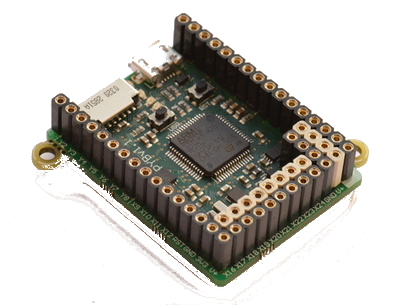
Figure: MicroPython Device  ¶
¶
The targeted devices are in general small SOC such as the original board. MicroPython represents on those devices the interactive Python interface as the user interface in complete replacement of a shell. This provides the inetractive communication as well as the automated batch execution of Python programs or small scripts.
The resources on these devices are extremely limited in comparison to the PC based platforms including their physically shrinked embedded variants. Therefore the runtime environment is to be customized by specific custom modules and build options. The platformids provides custom plugins with standard interfaces for the identification of the runtime environment.
For differences between CPython and MicroPython see [MicroVsCPython].
available soon
5.12.3.2. CircuitPython¶
The Python variant CircuitPython [CircuitPython] is a specialized variant provided by the company Adafruit Industries Inc. [ADAFRUIT] customized for it’s small devices.
For the module description refer to platformids.embed.circuitpython.
The targeted devices are small SOC such as the boards currently supported by CircuitPython [CircuitPython]
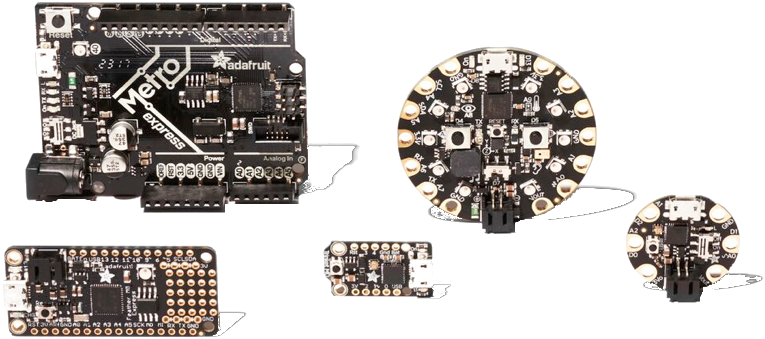
Figure: CircuitPython Device  ¶
¶
available soon
5.13. Custom Numbering Schemes¶
5.13.1. Concept¶
The actual enumeration of the underlying runtime platform of the OS and it’s distribution is two-fold. The supported standard distributions could be easily detected by using the standard libraries, while a lot of the distributions could not be detected easily. This is e.g. in parts the case for derived distributions, which keep the data of the base distribution, and add coexistently their own information. Another challange present the distributions based on rolling versions, where the majority does not support any easily accessible version information. The platformids provides for required special solutions easy a customization by support of user modules. These could easily add the required few data entries and if required custom callback funtions in addition. Which allow for specific dynamic adaptation to different version numbering layouts and schemes.
5.13.2. Custom API¶
The module platformids.__init__ defines the global basic interfaces for the acquisition and the conversion of the platform information.
5.13.2.1. Global Data¶
The main interface is provided by the global variables for the dynamic assignment and mapping of custom enum values.
These provide for
This comprises the function interfaces as well as the definition of the global data structures holding the machine readeable identifiers and the related mapping of human readable data. The custom data is required to be added to these structures when additional platforms are defined.
entry
data-type
type
option
description
rte2num
ProtectedDict
data-map
mandatory
maps of various data fields and formats to unique 32bit values, n:1 relation
num2rte
ProtectedDictEnum
data-map
mandatory
maps 32bit enum values to their assigned runtime information, 1:1 relation
num2pretty
ProtectedDictEnum
data-map
optional
maps the enum to it’s pretty name
num2enumstr
ProtectedDictEnum
data-map
optional
maps the string representation of enums for display
custom_rte_distrel2tuple
ProtectedDictEnum
data-map
optional
maps the custom converter for distrel
distrel2tuple
callable
callback
optional
converst a 32bit distrel value into segments
decode_version_str_to_segments
The supported numeric data-maps are of type ProtectedDictEnum, which supports the management of custom interger ranges. The free range of custom values is managed by the map object num2rte.
5.13.2.2. Functions¶
The module platformids.__init__ defines the global basic interfaces for the acquisition and the conversion of the platform information. This comprises the function interfaces as well as the definition of the global data structures holding the machine readeable identifiers and the related mapping of human readable data. The custom data is required to be added to these structures when additional platforms are defined.
entry
data-type
type
option
description
rte2num
ProtectedDict
data-map
mandatory
maps of various data fields and formats to unique 32bit values, n:1 relation
num2rte
ProtectedDictEnum
data-map
mandatory
maps 32bit enum values to their assigned runtime information, 1:1 relation
num2pretty
ProtectedDictEnum
data-map
optional
maps the enum to it’s pretty name
num2enumstr
ProtectedDictEnum
data-map
optional
maps the string representation of enums for display
custom_rte_distrel2tuple
ProtectedDictEnum
data-map
optional
maps the custom converter for distrel
distrel2tuple
callable
callback
optional
converst a 32bit distrel value into segments
decode_version_str_to_segments
The supported numeric data-maps are of type ProtectedDictEnum, which supports the management of custom interger ranges. The free range of custom values is managed by the map object num2rte.
5.13.2.3. Custom Callbacks and Data¶
The required entries are listed in the following table. Not all items are mandatory, thus when missing either defaults are used, or the specific feature is ignored.
entry
type
option
description
rte2num
data-map
mandatory
maps of various data fields and formats to unique 32bit values, n:1 relation
num2rte
data-map
mandatory
maps 32bit enum values to their assigned runtime information, 1:1 relation
num2pretty
data-map
optional
maps the enum to it’s pretty name
distrel2tuple
callback
optional
converst a 32bit distrel value into segments
Additional entries could be provided optionally, see for example the documentation of the module for Windows-NT platformids.dist.windows, and the NT specific list of possible products platformids.dist.windows_products.
The provided enumeration scheme comprises IDs for the major standard platforms. This includes the version IDs of releases by various versioning schemes [SWVERS]. Parts of the enumerated platforms are of considerable ranges. This is in particular the case for numbering schemes of the products of the family Windows-NT as well as for the Linux distributions.
In case of Linux the number of existing distribution is undefined, some sites are stating about 1000 distributions [DISTWATCH], [LinuxDist], and [LinuxDistComp]. The current relevant number of standard distributions - including subvariants - is here about 30, up to about 100. The versioning schemes comprise various variants, including rolling distributions [RollingDist] with date based image numbering schemes. Thus this versioning scheme requires a sufficient range for the dist enumeration field.
The major BSD derived distributions are based on an old-style linux versioning scheme, thus require not specific extended value ranges.
The prominent UNIX distribution OS-X based on BSD provides a 3-numbered numbering scheme, which by definitio is sparsely used, even though it reguires in sum a significant number of bits.
The numbering scheme of the Microsoft-Windows(C) OS family is basically a flat number with incremental mayor and minor version numbers, extended by an basically full-integer range for the build number. While here the ostype field is basically a constant for almost all OS releases since the mid of the 90s, the dist field specifies the distributed concrete vertsion of the ostype - WindowsNT - [VersionHelper], and [WINVERSIONS]. Thus this versioning scheme requires a sufficient range for the dist field.
The old traditional UNIX numbering scheme is based on a small number of UNIX distributions with moderately incremented release versions. The complete range of UNIX distributions in modern days comprise more variants and releases, including custom reelases as appliances. But these are still less than the open source distributions [UNIXHISTORY].
The platformids provides by default the major standard platforms from the box, while almost arbitrary enumeration type schemes could be added as custom schemes. The application on user defined platforms, such as specific non-standard OS distributions with arbitrary versioning paradigmas is provided by the introduction of custom numbering schemes. These provide the utilization of custom platforms integrated with standard platforms, even the combination of multipel independent custom platform enumeration schemes.
The customization is provided hereby either as complete subenvironments including the hierarchical subtypes as custom scheme content, or for the selected value only by using the standard utilities for the remaining platform identifier types.
The lists details the internal implementation of possible bit fields and resulting values for custom definitions. These are controlled by the significant bits, which also regroup the distribution bits for extended version number ranges.
Standard Type Reference:
The Standard Type Reference displays the applicable ranges for predefined enums. The remaining value ranges are reserved for custom definitions.
category:
The category provides 2-bits for custom values by setting the bits 31 and 30 to 1.
category-content:
The category-content locks the complete content for arbitrary custom usage by setting the bits 31 to 28 to 0. This is recognised by provided libraries and could be seamless applied for mixed definitions of standard and custom definitions.
ostype:
The ostype provides 4-bits for custom values by setting the bits 27 and 26 to 1.
ostype-content
The ostype-content locks the complete content for arbitrary custom usage by setting the bits 27 to 22 to 0. This is recognised by provided libraries and could be seamless applied for mixed definitions of standard and custom definitions.
dist:
The dist field provides the information for custom values of distribution IDs based on the standard size of the version field. The custom mde is enabled by setting the bit 21 to 1.
dist-ext
The dist field provides beneath the standard mode the extended mode for the regrouping of the dist and version flags. This works in the same way as for the extension of the standard distribution.
dist-content
The dist field owns a special role. The following field for the release version is in any case controlled by the assigned distribution, as it defines the context of the version scheme. Thus the dist-content is not required for the definition of a specific context for a distribution, this is the only and one standard case.
version
The version field contains the information of the release version. The applied scheme is defined individually by the selected distribution.
5.14. Customized Examples¶
The following sections describe the defintion of custom identifiers. The values are foreseen to be defined dynamically in order to assure the mix of multiple modules with independently defined enums. Thus the custom values should be in general referenced by provided values via variables, and not by their explicit numeric representation.
category |
ostype |
dist |
tested distrel |
bit-mask |
doc |
ref |
py |
test status |
|---|---|---|---|---|---|---|---|---|
scheme |
(8) |
|||||||
RTE_POSIX |
RTE_BSD |
RTE_DRAGONBSD |
c |
OK |
||||
RTE_GHOSTBSD |
||||||||
RTE_NOMADBSD |
c |
|||||||
RTE_TRUEOS |
c |
|||||||
RTE_LINUX |
RTE_BLACKARCH |
c |
OK |
|||||
RTE_LINUXMINT |
c |
OK |
||||||
RTE_PARROTOS |
c |
OK |
||||||
RTE_PENTOO |
c |
OK |
||||||
RTE_SLACK |
c |
OK |
||||||
RTE_MINIX |
RTE_MINIX2 |
c |
OK |
|||||
RTE_MINIX3 |
c |
OK |
||||||
RTE_UNIX |
RTE_AIX |
1.3 |
c |
|||||
RTE_WINDOWS |
RTE_REACTOS |
RTE_REACTOS5_2 |
0.4.9 |
c |
5.14.1. Custom OS-Type¶
5.14.1.1. Minix.Minix3¶
The Minix OS is defined on demand as a custom OS within the RTE_POSIX domain. The default distribution included is Minix3, which is dewfined by the project as a new distribution, thus a new type of dist.
The choosen numbering and naming scheme is therefore defined by the platformids in consistence to the overall layered categorization paradigm:
- category == RTE_POSIX:
The OS is designed as a Posix compatible OS.
- ostype == RTE_MINIX:
The code base is completely new with origin interfaces, thus a new ostype.
- dist == RTE_MINIX3:
The release Minix-3 of the type of distribution.
- distrel == RTE_MINIX330:
The product release of the distribution Minix-3.3.0.
The new custom entries are.
The Minix3 type of distribution is used here to introduce a new distel. Requires the previous creation and initialization of the ostype Minix.
5.14.1.2. ReactOS.ReactOS5_2¶
The ReactOS OS is defined on demand as a custom OS within the RTE_WINDOWS domain. The default distribution included is ReactOS5_2, which is defined by the project as compatible to the NT5_2 distribution of the fromer product Windows 2003 Server. The code base is completely disjunct but designed to provide runtime API compatibility, thus a new type of dist.
The choosen numbering and naming scheme is therefore defined by the platformids in consistence to the overall layered categorization paradigm:
- category == RTE_WINDOWS:
The OS is designed as a Windows compatible OS.
- ostype == RTE_REACTOS:
The code base is completely new, thus basically a new ostype.
- dist == RTE_ReactOS5_2:
The OS is a clone of NT5_2, thus same approach of numbering and naming.
- distrel == RTE_REACTOS049:
The OS is a clone of NT5_2 with an own release versioning scheme, thus similar approach of numbering and naming the distributions.
The new custom entries are.
The ReactOS5_2 type of distribution is used here to introduce a new distrel. Requires the previous creation and initialization of the ostype REACTOS.
See dist.custom.reactos, and [REACTOSVERSIONS].
5.14.2. Custom Distribution¶
5.14.2.1. AIX on x86 in a Virtual Machine¶
The AIX OS is available for the PowerPC platform only - but there is an ancient release for the x86 platform too. The AIX-1.3 / PS/2 release is a bit outdated of course,
IBM Sales Manual (US) - Document 5765-160 5765-160 IBM AIX PS/2 OPERATING SYSTEM V1.3 IBM U.S. Product Life Cycle Dates Program Marketing Service Replaced Number VRM Announced Available Withdrawn Discontinued By 5765-160 1.03.0 1992/09/21 1992/10/02 1995/03/10 - - See more…
This is the currently the only and one AIX release available for the x86 platform and could be installed within a VM without an CPU-Emulator of a PowerPC, e.g. within VirtualBox.
field
value
remarks
category
RTE_POSIX
ostype
RTE_UNIX
dist
RTE_AIX
distrel
1.03.0
schema default, platformids.custom.aix
The Aix-1.3 - PS/2 type of distribution is used here to introduce a new distel based on RTE_AIX
See dist.custom.aix.
5.14.2.2. BlackArch¶
The BlackArch distribution is based on ArchLinux, thus supports the same release versioning scheme.
type
enum
string
remarks
category
RTE_POSIX
posix
ostype
RTE_LINUX
linux
dist
RTE_BLACKARCH
blackarch
distrel
see blackarch.py
schema default
pretty
BlackArch
The applied encoding is here the default pattern.
Examples are:
drag0nflybsd-5.4.0 => drag0nflybsd-5.4.0
See DragonFlyBSD.py
5.14.2.3. DragonFlyBSD¶
The DragonFlyBSD distribution supports as major releases a 2-number scheme, while intermediate releases until 4.0.x have 3-number release versions.
type
enum
string
remarks
category
RTE_POSIX
posix
ostype
RTE_BSD
bsd
dist
RTE_DRAGONFLYBSD
dragonflybsd
distrel
see dragonbsd.py
[DRAGONFLYVERSIONS], schema default
pretty
DragonFlyBSD
The applied encoding is here the default pattern.
Examples are:
drag0nflybsd-5.4.0 => drag0nflybsd-5.4.0
See DragonFlyBSD.py
5.14.2.4. GhostBSD¶
The GhostBSD distribution supports as major releases a 2-number scheme.
type
enum
string
remarks
category
RTE_POSIX
posix
ostype
RTE_BSD
bsd
dist
RTE_GHOSTBSD
ghostbsd
distrel
see ghostbsd.py
schema default
pretty
GhostBSD
The applied encoding is here the default pattern.
Examples are:
ghostbsd-19.4.0 => ghostbsd-19.4.0
See GhostBSD.py
5.14.2.5. LinuxMint¶
Adds the LinuxMint distribution to the ostype Linux.
The new custom entries are.
field
value
remarks
category
RTE_POSIX
ostype
RTE_LINUX
dist
RTE_LINUXMINT
[LinuxMint], as custom type
distrel
19.1
schema default
See custom.linuxmint.
5.14.2.6. Minix2¶
The Minix2 type of distribution is used here to introduce a new distel. Requires the previous creation and initialization of the ostype Minix.
The new custom entries are.
The Minix2 type of distribution is used here to introduce a new distel. Requires the previous creation and initialization of the ostype Minix.
5.14.2.7. NomadBSD¶
The NomadBSD distribution supports as major releases a 2-number scheme.
type
enum
string
remarks
category
RTE_POSIX
posix
ostype
RTE_BSD
bsd
dist
RTE_NOMADBSD
nomadbsd
distrel
see nomadbsd.py
schema default
pretty
NomadBSD
The applied encoding is here the default pattern.
Examples are:
nomadbsd-1.2.0 => nomadbsd-1.2.0
See NomadBSD.py
5.14.2.8. Parrot Linux¶
Adds the Parrot Linux distribution to the ostype Linux.
The new custom entries are.
field
value
remarks
category
RTE_POSIX
ostype
RTE_LINUX
dist
RTE_PARROT
[ParrotOS], as custom type
distrel
4.1
schema default
4.5.1
schema default
See dist.custom.parrot.
5.14.2.9. Pentoo Linux¶
Adds the Pentoo Linux distribution to the ostype Linux.
The new custom entries are.
See dist.custom.pentoo.
5.14.2.10. Slackware¶
type
enum
string
remarks
category
RTE_POSIX
posix
ostype
RTE_LINUX
linux
dist
RTE_SLACK
slackware
distrel
see slackware.py
[SLACKVERSIONS], schema default
pretty
Slackware
The distribution Slackware applies the standard pattern for a 2-number version, while the actual release schedule is state-driven [SLACKWARE].
Examples are:
slackware-13.0 - 2009-08-26
slackware-13.1 - 2010-05-24
slackware-13.37 - 2011-04-27
slackware-14.0 - 2012-09-28
slackware-14.1 - 2013-11-04
slackware-14.2 - 2016-06-30
The applied encoding is here the default pattern.
See slackware.py
5.15. Resources¶
Comparison of BSD operating systems [OSCompBSD]
Comparison of Linux distributions [OSCompLinux]
Comparison of Microsoft Windows versions [OSCompMSWin]
Comparison of operating systems [OSComp]
Cygwin [CYGWIN]
DistroWatch Page Hit Ranking [LinuxPopular]
Firmware [FIRMWARE]
IEEE Std 1003.1(TM), 2013 Edition [IEEE1003]
IEEE Std 1003.1(TM), 2013 Edition [POSIX]
IEEE Std 1003.1(TM), 2013 Edition; Chapter 4.12 [IEEE1003C412]
Linux Standard Base Core Specification, Generic Part [LSBCORE]
Linux Standard Base Specification [LSB]
Linux on embedded systems [LinuxEmbed]
List of Microsoft Windows versions [WINVERSIONS]
List of operating systems [OSList]
Microsoft Windows [OSWindows]
Microsoft Windows _OSVERSIONINFOA structure [OSVERSIONINFO]
Operating System [OperatingSystem]
Operating Systems [OSListLarge]
Rolling Distribution [RollingDist]
Shell (computing) - [SHELL]
Single UNIX Specification (SUS) [SUS]
Software Versioning [SWVERS]
Text (CLI) shells - [SHELLTXT]
UNIX 3 [SUS]
Unix History - Simplified Overview [UNIXHISTORY]
Unix [UNIX]
Usage share of operating systems [OSUsage]
Windows - Modern Lifecycle Policy FAQ [WIN10LIFECYCLEFAQ]
Windows 10 - Release information [WIN10RELEASEINFO]
Windows 10 and Windows Server update history [WIN10UPDATEHIST]
Windows 10 version history [WIN10VERSIONS]
Windows NT SDK: Macros for Conditional Declarations - [MACROSRELCOND]
Windows lifecycle fact sheet [WIN10LIFECYCLE]
_winreg — Windows registry access [WINREG2]
lib/os; Python2 and Python3 [os]
winreg — Windows registry access [WINREG3]
lib/base64 [base64]
